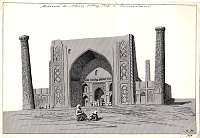Crossroads of the World: An Adventure Across Central Asia
#1
Original Poster
Join Date: Sep 2012
Posts: 3,158
Likes: 0
Received 0 Likes
on
0 Posts
Crossroads of the World: An Adventure Across Central Asia
Central Asia. Where exactly is it? How is it defined? Well, it depends... The most widely accepted definition of the region incorporates the five former Soviet republics of Kazakhstan, Kyrgyzstan, Uzbekistan, Turkmenistan, and Tajikistan. More expansive definitions incorporate some or all of Afghanistan, East Turkestan, Mongolia, and Tibet. Central Asia sits at the intersection of major world powers of today and yesterday - Russia, China, Mongolia, India, Persia, and even Turkey. It is a region where civilizations met, sometimes peacefully and other times violently. The cities of Samarkand and Bukhara were important trading centers along the Silk Road that connected China with the Middle East and Europe. Central Asia enjoyed a golden age in the early part of the second millennium, during which time Timur (or Tamerlane) ruled much of the region and was responsible for building many of the Islamic masterpieces, some of which are still standing today. Except for Persian Tajikistan, today's Central Asian peoples are majority Turkic and Sunni Muslim.
Our three-week visit to the region takes us to a slice of this part of the world. We will begin our visit with nine nights in Uzbekistan travelling from Tashkent to Samarkand, stopping in Khiva and in Bukhara along the way. From Uzbekistan, we then travel to Kazakhstan, where we will visit Almaty and Zhetysu. From there, we continue on to Kyrgyzstan. We will circle Lake Issyk-Kul and end in Bishkek. Yes, three weeks is not a lot of time for the amount of geography we're covering but it's what we have. We hope to marvel at the man-made wonders of Uzbekistan and immerse among the natural wonders of Kazakhstan and Kyrgyzstan.
Tashkent, here we come.
Our three-week visit to the region takes us to a slice of this part of the world. We will begin our visit with nine nights in Uzbekistan travelling from Tashkent to Samarkand, stopping in Khiva and in Bukhara along the way. From Uzbekistan, we then travel to Kazakhstan, where we will visit Almaty and Zhetysu. From there, we continue on to Kyrgyzstan. We will circle Lake Issyk-Kul and end in Bishkek. Yes, three weeks is not a lot of time for the amount of geography we're covering but it's what we have. We hope to marvel at the man-made wonders of Uzbekistan and immerse among the natural wonders of Kazakhstan and Kyrgyzstan.
Tashkent, here we come.
#5
Original Poster
Join Date: Sep 2012
Posts: 3,158
Likes: 0
Received 0 Likes
on
0 Posts
progol, thank you. I hope you enjoy Nafplion as much as we did. Do visit Mystras if you have the time.
shelemm, thank you. I am excited about the experiences ahead. Right now, I’m expecting some mix of Turkey, the Middle East, and the South Caucasus.
shelemm, thank you. I am excited about the experiences ahead. Right now, I’m expecting some mix of Turkey, the Middle East, and the South Caucasus.
#6
Original Poster
Join Date: Sep 2012
Posts: 3,158
Likes: 0
Received 0 Likes
on
0 Posts
May 8: Tashkent
We arrived in Tashkent at just past four in the morning, after having travelled via London and Istanbul. From there, we travelled by taxi to our hotel. As our rooms were not ready for occupancy, we dropped our bags off, enjoyed a leisurely breakfast in the hotel, freshened up in the lobby’s facilities, and pounded the pavement for a full day of sightseeing. Relying upon a Lonely Planet guidebook to Central Asia, some online resources, and a map of the city, we cobbled together a walking tour of our own focused in the city center of Tashkent.
Tashkent is the capital city of Uzbekistan. It is also the largest city in Central Asia, and fourth largest in the final days of the Soviet Union. Much of the city destroyed by an earthquake in 1966, much of the city was rebuilt in the Soviet style. All over Tashkent are examples of Soviet-style architecture as well as faux European architecture, with very few Uzbek or Islamic style buildings.
Our first stop was Independence Square, adorned with a large archway supported by several columns featuring several storks, a repurposed Soviet era mountain, and several fountains. From there we walked over to the World War II memorial with its eternal flame and down wide, tree-lined Alistair Navoi Avenue, with its massive white- or cream-colored government buildings and institutions.
We then visited the Timurid Museum, with its beautiful green dome exterior and beautiful tiled ceiling, chandelier, and mural of Amir Timur (also known as Timerlane) in the interior. The exhibits featured replicas of the major public works of art built in the 14th and 15th centuries across Timur’s empires, most of which are in Samarkand and Bukhara to the west of Tashkent.
From there we strolled over to Amir Timur Square with a statue of the namesake on horseback. Running away from the square back towards Independence Square is Sayilgoh Ko’chasi, a pleasant pedestrianized street with cafes and kiosks selling souvenirs on both sides.
Next up is the State Museum of the History of Uzbekistan, which featured two floors of exhibits. The second floor focused on early archaeology and the artifacts of the golden age of the 14th and 15th centuries are more interesting that the third floor exhibits about modern-day Uzbekistan.
We then visited the Art Gallery of Uzbekistan. Contained in a massive Soviet-era building directly across from Independence Square, it contained a modest but worthwhile collection of different genres of art from a variety of Uzbek artists.
From here we ventured further afield, heading north to the Minor Mosque, passing a memorial to the victims of the 1966 earthquake. The mosque consists of a turquoise dome encircled by a rectangular courtyard with two mostly white rectangular buildings. The style is different from the mosques we’ve seen elsewhere.
Next to the mosque is the Ankhor Canal, which we followed back towards where we came. We made one more stop at Sheikhantaur Mausoleum Complex, which consists of three small buildings built in the Timur style.
The entire walk around town took about seven hours, including a couple of stops for water and a longer coffee break. Strolling around the streets of Tashkent was very pleasant. The boulevards are wide with tall trees lined on both sides. There are ample space on the sidewalks and it was clean. Overall, the city has a refined but laid-back atmosphere. The air felt somewhat but the city most reminds me of Baku, the capital of Azerbaijan. The only drawback of the day was the high heat – 91 degrees Fahrenheit – and humidity.
After we were done with our self-devised tour, we headed back to our hotel to check into our rooms and rest for a couple of hours. Then we ventured out again for dinner. We ate at Afsona, a contemporary Uzbek restaurant serving salads, various meat dishes, and grilled meats.

Independence Square Arch
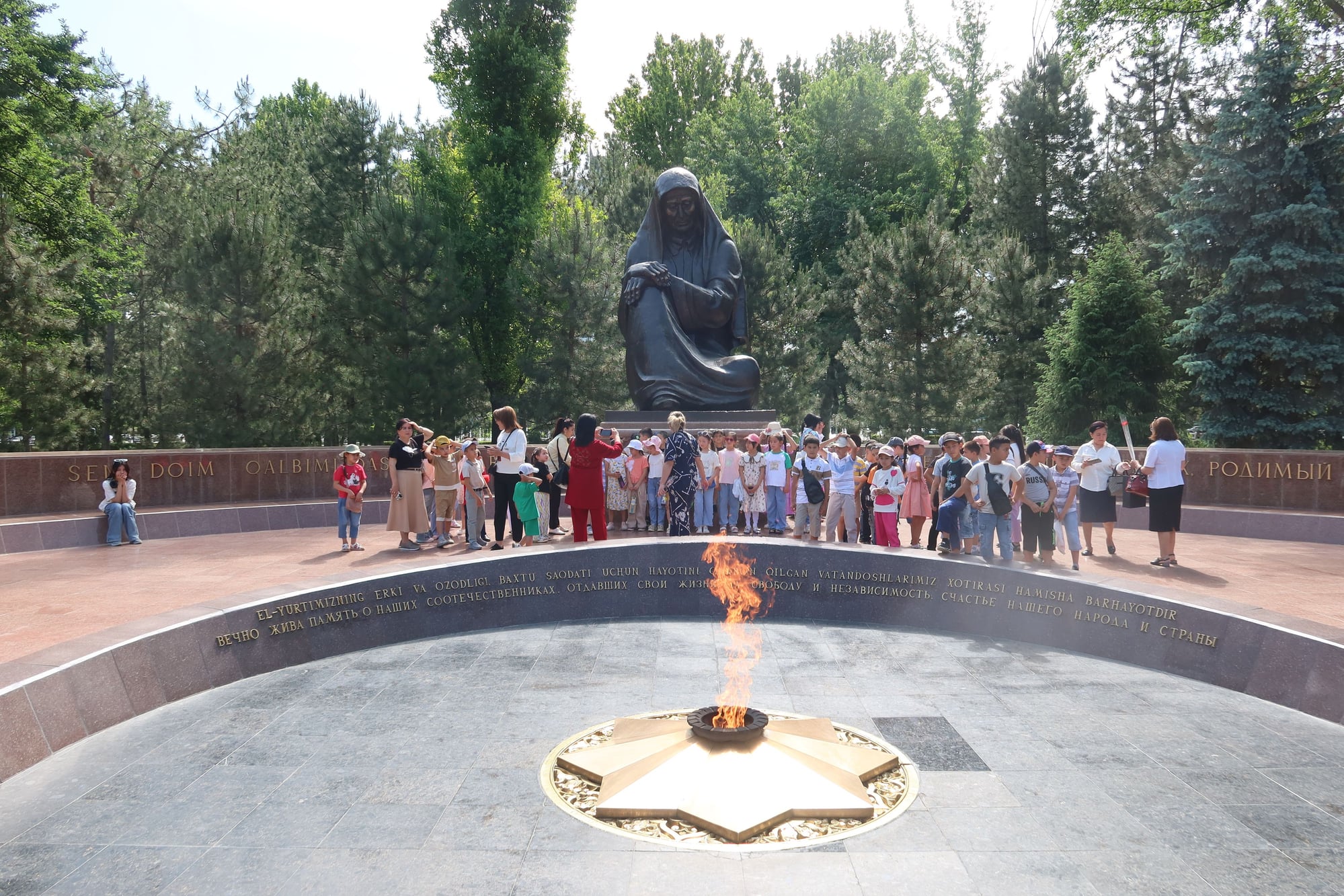
World War II Memorial
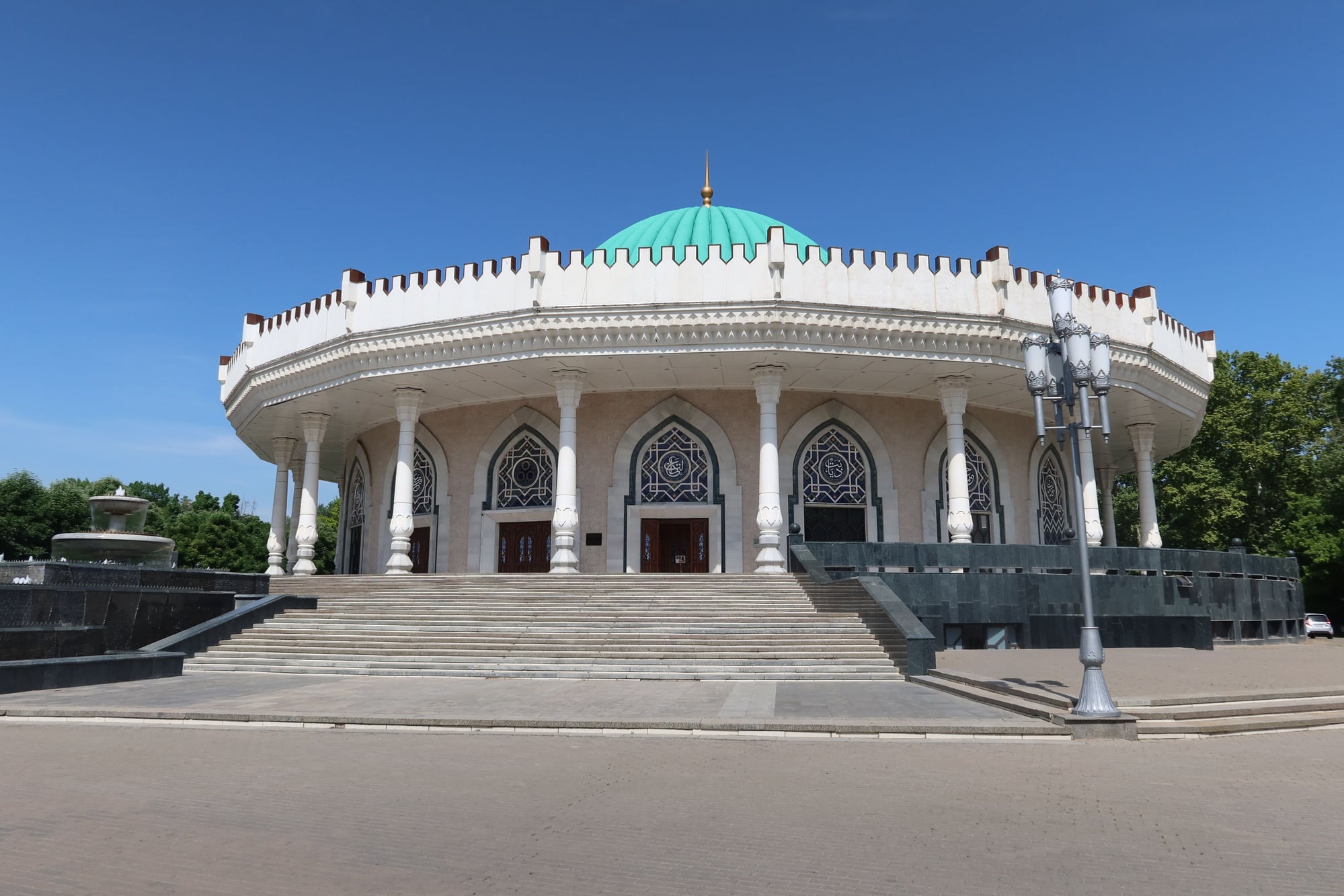
Timurid Museum
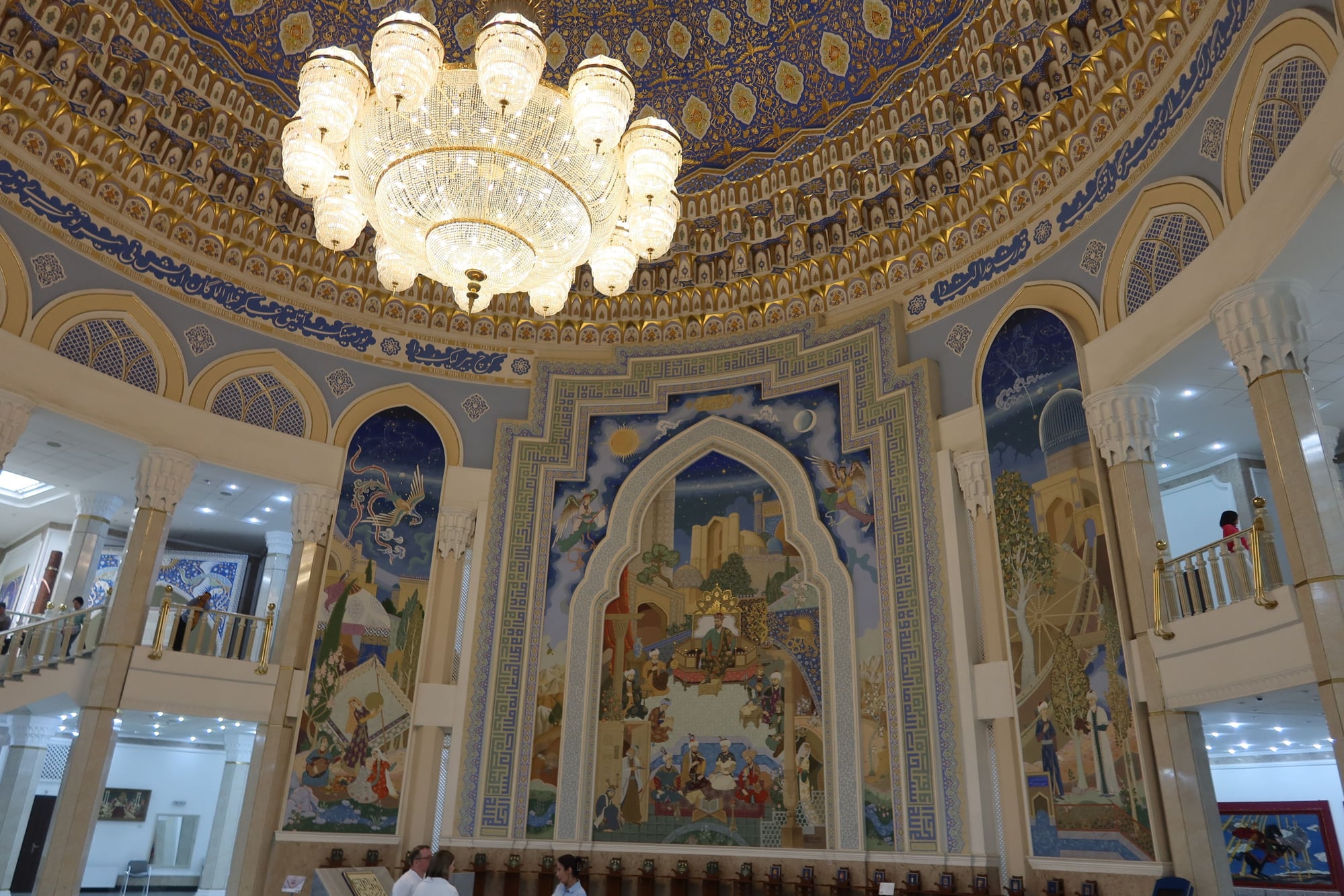
Chandelier and Mural at Timurid Museum

1966 Earthquake Memorial

Minor Mosque

Sheikhantaur Mausoleum Complex

Amir Timur Square
We arrived in Tashkent at just past four in the morning, after having travelled via London and Istanbul. From there, we travelled by taxi to our hotel. As our rooms were not ready for occupancy, we dropped our bags off, enjoyed a leisurely breakfast in the hotel, freshened up in the lobby’s facilities, and pounded the pavement for a full day of sightseeing. Relying upon a Lonely Planet guidebook to Central Asia, some online resources, and a map of the city, we cobbled together a walking tour of our own focused in the city center of Tashkent.
Tashkent is the capital city of Uzbekistan. It is also the largest city in Central Asia, and fourth largest in the final days of the Soviet Union. Much of the city destroyed by an earthquake in 1966, much of the city was rebuilt in the Soviet style. All over Tashkent are examples of Soviet-style architecture as well as faux European architecture, with very few Uzbek or Islamic style buildings.
Our first stop was Independence Square, adorned with a large archway supported by several columns featuring several storks, a repurposed Soviet era mountain, and several fountains. From there we walked over to the World War II memorial with its eternal flame and down wide, tree-lined Alistair Navoi Avenue, with its massive white- or cream-colored government buildings and institutions.
We then visited the Timurid Museum, with its beautiful green dome exterior and beautiful tiled ceiling, chandelier, and mural of Amir Timur (also known as Timerlane) in the interior. The exhibits featured replicas of the major public works of art built in the 14th and 15th centuries across Timur’s empires, most of which are in Samarkand and Bukhara to the west of Tashkent.
From there we strolled over to Amir Timur Square with a statue of the namesake on horseback. Running away from the square back towards Independence Square is Sayilgoh Ko’chasi, a pleasant pedestrianized street with cafes and kiosks selling souvenirs on both sides.
Next up is the State Museum of the History of Uzbekistan, which featured two floors of exhibits. The second floor focused on early archaeology and the artifacts of the golden age of the 14th and 15th centuries are more interesting that the third floor exhibits about modern-day Uzbekistan.
We then visited the Art Gallery of Uzbekistan. Contained in a massive Soviet-era building directly across from Independence Square, it contained a modest but worthwhile collection of different genres of art from a variety of Uzbek artists.
From here we ventured further afield, heading north to the Minor Mosque, passing a memorial to the victims of the 1966 earthquake. The mosque consists of a turquoise dome encircled by a rectangular courtyard with two mostly white rectangular buildings. The style is different from the mosques we’ve seen elsewhere.
Next to the mosque is the Ankhor Canal, which we followed back towards where we came. We made one more stop at Sheikhantaur Mausoleum Complex, which consists of three small buildings built in the Timur style.
The entire walk around town took about seven hours, including a couple of stops for water and a longer coffee break. Strolling around the streets of Tashkent was very pleasant. The boulevards are wide with tall trees lined on both sides. There are ample space on the sidewalks and it was clean. Overall, the city has a refined but laid-back atmosphere. The air felt somewhat but the city most reminds me of Baku, the capital of Azerbaijan. The only drawback of the day was the high heat – 91 degrees Fahrenheit – and humidity.
After we were done with our self-devised tour, we headed back to our hotel to check into our rooms and rest for a couple of hours. Then we ventured out again for dinner. We ate at Afsona, a contemporary Uzbek restaurant serving salads, various meat dishes, and grilled meats.

Independence Square Arch

World War II Memorial

Timurid Museum

Chandelier and Mural at Timurid Museum

1966 Earthquake Memorial

Minor Mosque

Sheikhantaur Mausoleum Complex

Amir Timur Square
#9
Original Poster
Join Date: Sep 2012
Posts: 3,158
Likes: 0
Received 0 Likes
on
0 Posts
Mel, thank you. We feel very fortunate to be able to travel with loved ones and be healthy enough to be able to do all that we do. It's something that we don't take for granted.
shelemm, Tashkent was definitely a surprise for me. I expected an okay city, a transit point to the more exciting cities of Bukhara and Samarkand if you will, but truly enjoyed our time here. Tashkent is large but manageable. It's pleasant for strolling, especially among the tree-lined streets, which seem to be everywhere. The sidewalks are very wide and there's no litter to speak of anywhere. With two full days, we felt we were able to get a good introductory feel of the city and came away with some memorable experiences.
Addendum to May 8 report
I realize that I unintentionally left off the name of the restaurant at which we ate for dinner last night, which is Afsona.
I also left out the hotel at where we’re staying, the Hyatt Regency. Located on popular Navoi Avenue, it is close to all the major sights in the downtown core of Tashkent and within 10-15minutes of walking to three Metro stations. The hotel is modern and comfortable, although don’t expect character; it’s a typical business hotel. The rooms are nice though. The service is somewhat mixed.
May 9: Tashkent
We spent our second full day in Tashkent away from the city center, exploring other parts of this geographically large city. In my research, I came across a good suggested walking tour of Tashkent from Caravanistan (Walking Old Tashkent | Caravanistan), which is what we used today.
After a full breakfast at our hotel, we travelled by Metro to Tinchlik. A ride on the Metro is an attraction in itself in Tashkent. The stations, built by the Soviet Union when Uzbekistan was under its sovereignty, are massive, with heavy uses of stone and marble. There are ornamentations everywhere, from the lettering of the station names (in Cyrillic) to the tiles featuring geometric patterns and mosaics to Uzbek and Soviet heroes as well as beautiful chandeliers, what we may expect to see in major cities in Russia. The train sets itself are a hodgepodge of Soviet era cars and contemporary sleeker cars.
We first visited the small Chigatoy Bazaar and the nearby mosque of the same name. Both were very busy this morning but all with locals. We were probably the only tourists there, and were met with both curiosity and tremendous hospitality. There’s not much to see here, but the experiences we had with the local shoppers and the worshippers were very worthwhile.
From here we made our way to Hazmati Imam Complex, winding our way through a very traditional part of Tashkent filled with winding lanes that made me think of Fez, Morocco. The lanes were filled with homes made of simple, mud-filled walls and tin roofs. This is definitely not the European Tashkent that we visited yesterday.
Hazmati Imam Complex occupies a large site. It consists of an enormous mausoleum that was under construction and closed to the public, a madrasa turned into souvenir shops (disappointing), a small mosque, and a couple of large buildings, all around a big public square. The architecture, of huge brick walls decorated with Arabic-inspired tile patterns and green domes, is iconic Islamic, which we very much enjoyed. While the exterior of the buildings are impressive, there’s nothing to see on the inside, which to me diminished the value of the visit.
Next up is Chorsu Bazaar, the largest shopping center in Tashkent. Housed under a massive blue dome roof, the market spilled out to surrounding buildings as well as the areas outside the buildings. Sold here are everything from grains and spices to meats, produce, clothing, and tourist souvenirs. The market was very busy and filled with locals out to do their shopping. It was fun to wander among the stalls and mingle among the crowd. Oh, and if you like strawberries, you will be in heaven here.
Not too far from Chorsu Bazaar is Kolkadosh Madrasa, a school still being used today. The building consists of a massive entrance portal and a beautiful courtyard on the inside, with classrooms all around. Next to the madrasa is the Friday Mosque, a beautiful house of worship with its impressive geometric dome and chandelier.
We then made our way down Furkat Street and Bunyodkor Avenue, just enjoying the cityscape of Tashkent. We soon came upon a few important buildings including the Friendship Palace and the lower house of Parliament. We ended our way with a stroll through leafy Milliy Bog park. Adjacent to the park is Magic City, an amalgamation of restaurants and shops housed within buildings that look like fake versions of major European cities. Definitely kitchy and Disneyeque.
From there it was a short walk to a Metro stop. Dinner tonight was at Basilic, a high-end restaurant with a good variety of food selections ranging from typical Western to Japanese. The quality of the food was excellent and the service matching it.
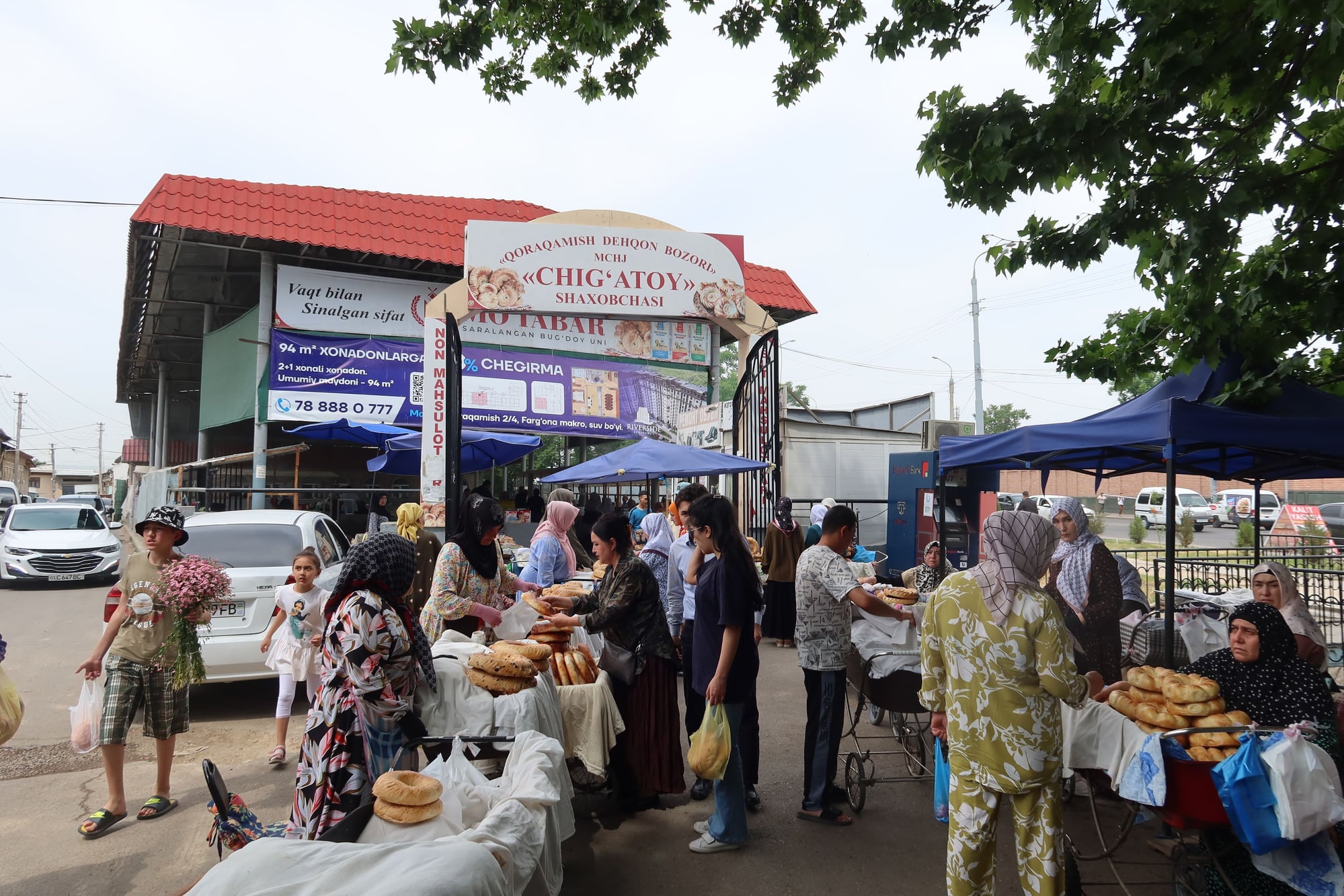
Chigatoy Bazaar

Non (bread)
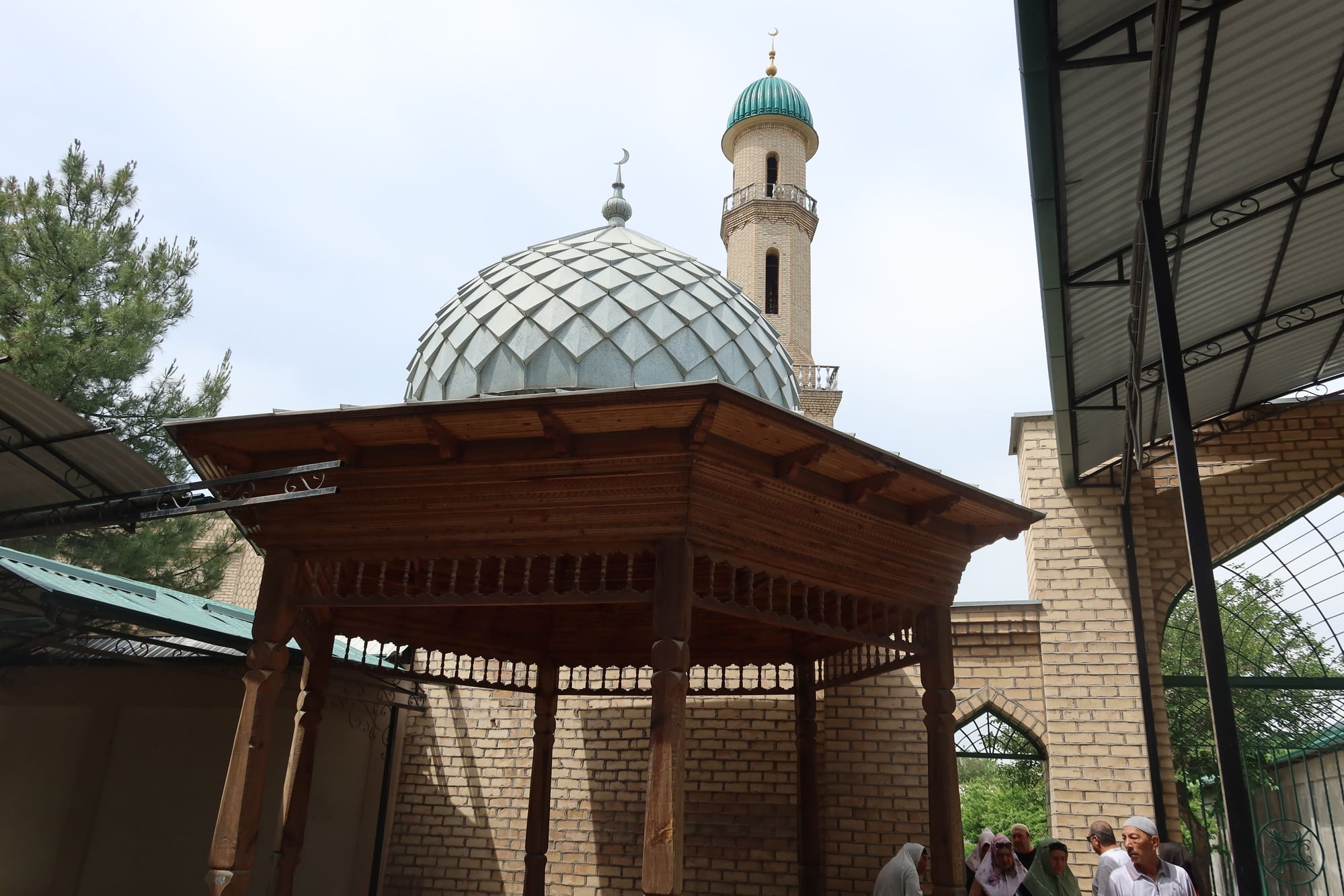
Chigatoy Mosque
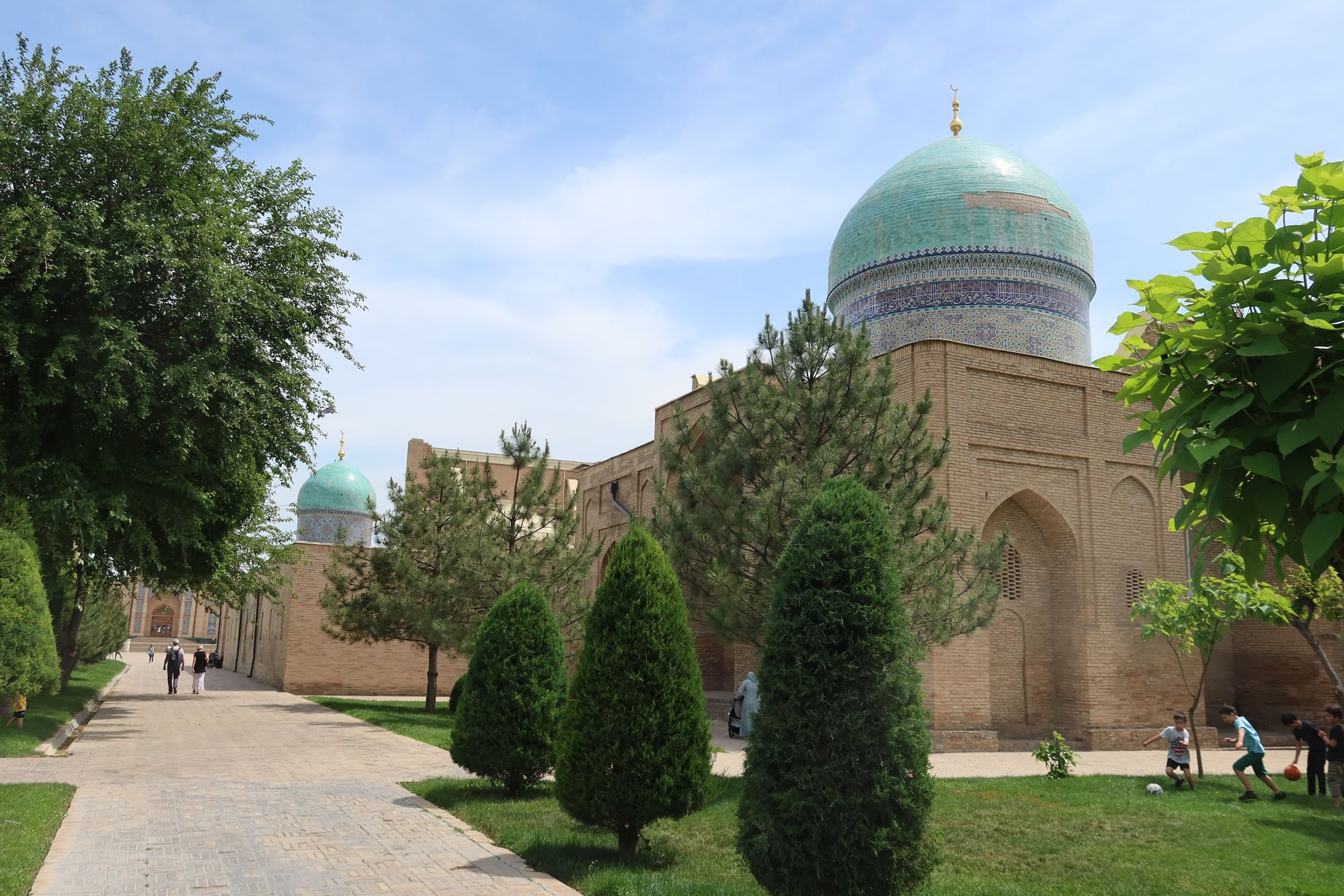
Madrasa at Hazrati Imam Complex

Entrance Portal to Madrasa
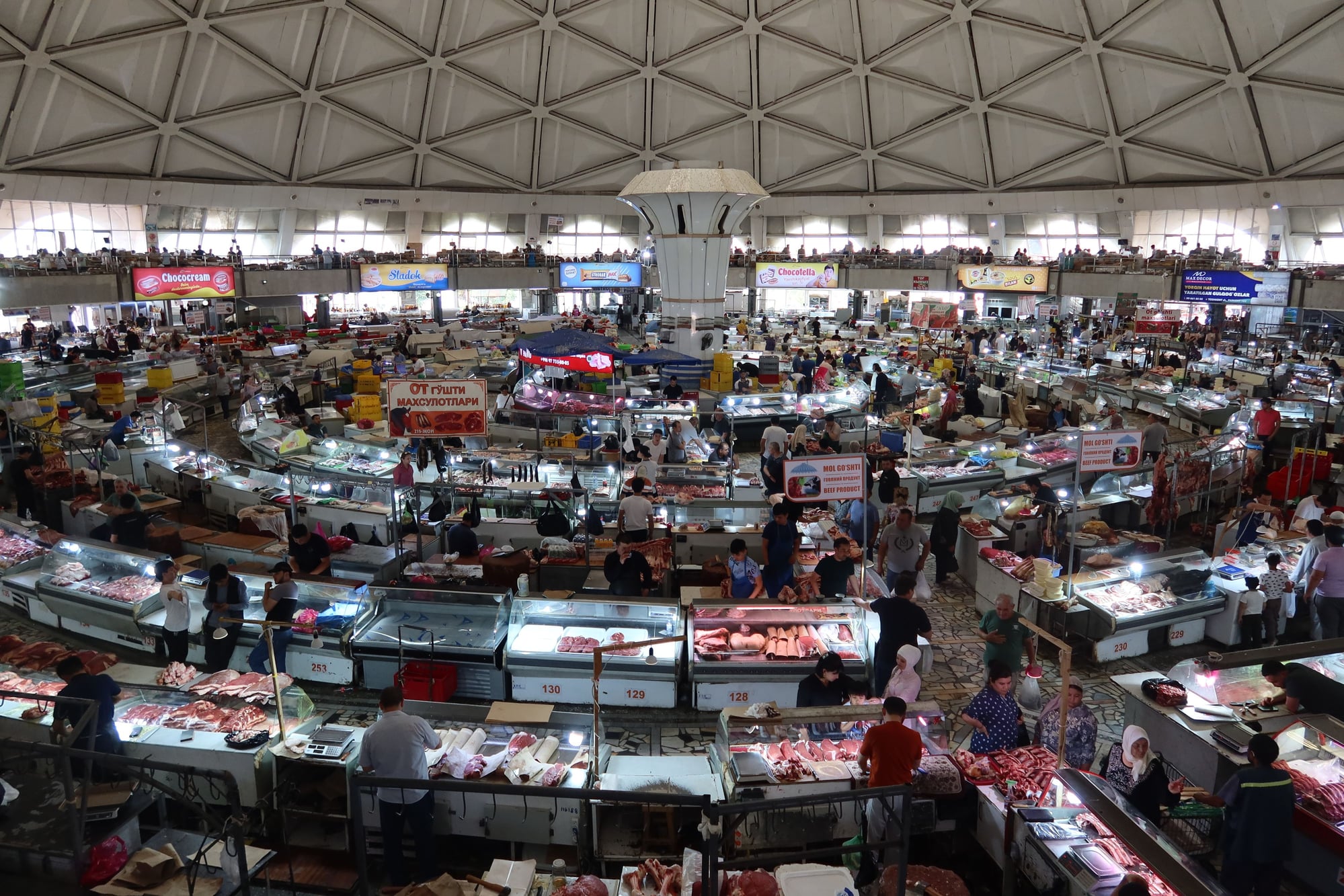
Inside Chorsu Bazaar, with many stalls under one dome

Kolkadosh Madrasa
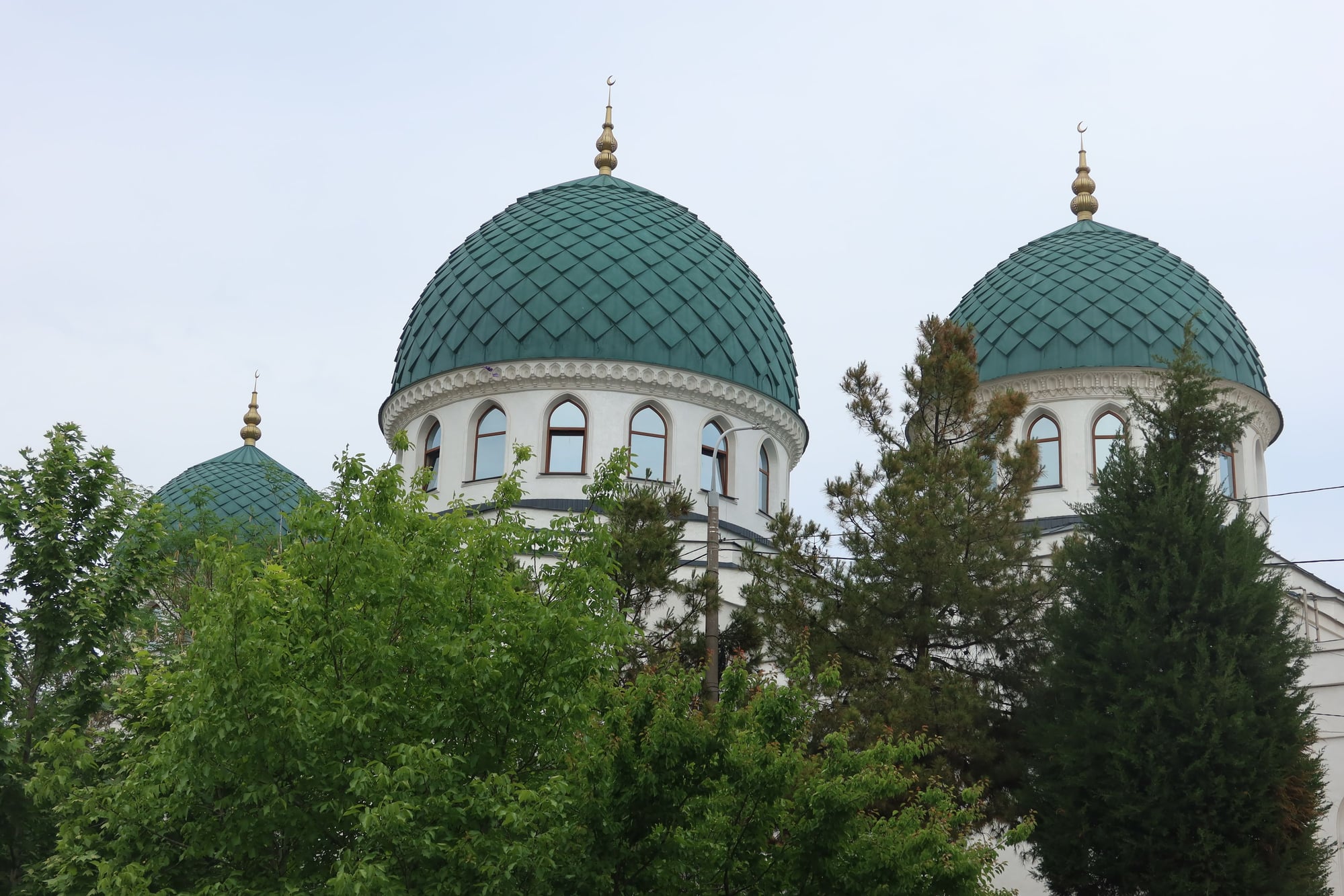
Friday Mosque

Friendship Palace
shelemm, Tashkent was definitely a surprise for me. I expected an okay city, a transit point to the more exciting cities of Bukhara and Samarkand if you will, but truly enjoyed our time here. Tashkent is large but manageable. It's pleasant for strolling, especially among the tree-lined streets, which seem to be everywhere. The sidewalks are very wide and there's no litter to speak of anywhere. With two full days, we felt we were able to get a good introductory feel of the city and came away with some memorable experiences.
Addendum to May 8 report
I realize that I unintentionally left off the name of the restaurant at which we ate for dinner last night, which is Afsona.
I also left out the hotel at where we’re staying, the Hyatt Regency. Located on popular Navoi Avenue, it is close to all the major sights in the downtown core of Tashkent and within 10-15minutes of walking to three Metro stations. The hotel is modern and comfortable, although don’t expect character; it’s a typical business hotel. The rooms are nice though. The service is somewhat mixed.
May 9: Tashkent
We spent our second full day in Tashkent away from the city center, exploring other parts of this geographically large city. In my research, I came across a good suggested walking tour of Tashkent from Caravanistan (Walking Old Tashkent | Caravanistan), which is what we used today.
After a full breakfast at our hotel, we travelled by Metro to Tinchlik. A ride on the Metro is an attraction in itself in Tashkent. The stations, built by the Soviet Union when Uzbekistan was under its sovereignty, are massive, with heavy uses of stone and marble. There are ornamentations everywhere, from the lettering of the station names (in Cyrillic) to the tiles featuring geometric patterns and mosaics to Uzbek and Soviet heroes as well as beautiful chandeliers, what we may expect to see in major cities in Russia. The train sets itself are a hodgepodge of Soviet era cars and contemporary sleeker cars.
We first visited the small Chigatoy Bazaar and the nearby mosque of the same name. Both were very busy this morning but all with locals. We were probably the only tourists there, and were met with both curiosity and tremendous hospitality. There’s not much to see here, but the experiences we had with the local shoppers and the worshippers were very worthwhile.
From here we made our way to Hazmati Imam Complex, winding our way through a very traditional part of Tashkent filled with winding lanes that made me think of Fez, Morocco. The lanes were filled with homes made of simple, mud-filled walls and tin roofs. This is definitely not the European Tashkent that we visited yesterday.
Hazmati Imam Complex occupies a large site. It consists of an enormous mausoleum that was under construction and closed to the public, a madrasa turned into souvenir shops (disappointing), a small mosque, and a couple of large buildings, all around a big public square. The architecture, of huge brick walls decorated with Arabic-inspired tile patterns and green domes, is iconic Islamic, which we very much enjoyed. While the exterior of the buildings are impressive, there’s nothing to see on the inside, which to me diminished the value of the visit.
Next up is Chorsu Bazaar, the largest shopping center in Tashkent. Housed under a massive blue dome roof, the market spilled out to surrounding buildings as well as the areas outside the buildings. Sold here are everything from grains and spices to meats, produce, clothing, and tourist souvenirs. The market was very busy and filled with locals out to do their shopping. It was fun to wander among the stalls and mingle among the crowd. Oh, and if you like strawberries, you will be in heaven here.
Not too far from Chorsu Bazaar is Kolkadosh Madrasa, a school still being used today. The building consists of a massive entrance portal and a beautiful courtyard on the inside, with classrooms all around. Next to the madrasa is the Friday Mosque, a beautiful house of worship with its impressive geometric dome and chandelier.
We then made our way down Furkat Street and Bunyodkor Avenue, just enjoying the cityscape of Tashkent. We soon came upon a few important buildings including the Friendship Palace and the lower house of Parliament. We ended our way with a stroll through leafy Milliy Bog park. Adjacent to the park is Magic City, an amalgamation of restaurants and shops housed within buildings that look like fake versions of major European cities. Definitely kitchy and Disneyeque.
From there it was a short walk to a Metro stop. Dinner tonight was at Basilic, a high-end restaurant with a good variety of food selections ranging from typical Western to Japanese. The quality of the food was excellent and the service matching it.

Chigatoy Bazaar

Non (bread)

Chigatoy Mosque

Madrasa at Hazrati Imam Complex

Entrance Portal to Madrasa

Inside Chorsu Bazaar, with many stalls under one dome

Kolkadosh Madrasa

Friday Mosque

Friendship Palace
#10
Join Date: Mar 2014
Posts: 4,492
Likes: 0
Received 0 Likes
on
0 Posts
Wow! Just saw this. Sounds like a very interesting, intriguing and mysterious part of the world. Mysterious because I don't know much about it. We probably won't make it to this part of the world so I'll be following along and enjoying vicariously through your report and photos.
#11
Fascinating report with excellent photos. I've had an interest in that part of the world but like Karen, it's unlikely that I'll make it there, so I will also enjoy following your trip. (Closest, perhaps, being Yunnan Province, which was half a world away and decades in time away.)
On question if you don't mind: In post #6 you say, "The air felt somewhat but the city most reminds me of Baku ...". Is there a word missing between "somewhat" and "but"?
On question if you don't mind: In post #6 you say, "The air felt somewhat but the city most reminds me of Baku ...". Is there a word missing between "somewhat" and "but"?
#12
Join Date: Mar 2014
Posts: 4,492
Likes: 0
Received 0 Likes
on
0 Posts
Nelson, interesting that you've been to Yunnan Province. We were there in 2017 and enjoyed it very much. The most unique place I've visited is Xinjiang Province, especially Kashgar and the Sunday Market. We definitely want to visit SE Asia, but I don't know how many of these long-haul flights our ageing bodies can handle. So I don't think we will make it to central Asia.
So I don't think we will make it to central Asia.
Tripplanner001, how long did it take you to get there from the US?
 So I don't think we will make it to central Asia.
So I don't think we will make it to central Asia. Tripplanner001, how long did it take you to get there from the US?
#14
Original Poster
Join Date: Sep 2012
Posts: 3,158
Likes: 0
Received 0 Likes
on
0 Posts
KarenWoo, thanks for following along and commenting. It's definitely a part of the world where there is less information. Pulling together information to build our itinerary was challenging for this reason; the Lonely Planet's guide to Central Asia is good though. DC to Tashkent flight time was about 15 hours (7 hours DC to London, 3.5 hours London to Istanbul, and 4.5 hours Istanbul to Tashkent).
Nelson, thanks for catching that. The missing word is "Parisian".
shelemm, so far, Uzbekistan has most reminded me of our trip to the South Caucasus. Not just as for Soviet republics, but parts of the world with such a mix of history, cultures, and traditions, and yet so little information available. We continue to be pleasantly surprised each and every day.
May 10: Khiva
We flew from Tashkent to Urgench at the crack of dawn this morning. The flight on Uzbekistan Airways, the flagship carrier, was smooth and uneventful. The westward journey took about one and a half hours. From there it was a 40-kilometer taxi ride to Khiva, one of the three most important golden age cities in Uzbekistan.
The early arrival allowed us close to a full day in Khiva (we had originally wanted two nights in Khiva but had to settle with one given our stops elsewhere and the overall time limitations for this trip). We spent all of our time today in the Ichan Qala, the old urban core of historic Khiva. Enclosed by city walls built during its heyday, Khiva was home to numerous madrasas, mosques, and places of commerce, as well as residences. While some people still live within these old city walls, its entire existence today is dependent upon tourism. This could not be more evident than today.
Walking from our hotel, the Hotel Bankir, a small, simple hotel a few minutes by foot from the West Gate into Old Khiva, we eagerly anticipated the place we were about to visit and were immediately impressed upon the site of the brown fortress walls and the distinctive unfinished minaret. However the feelings of wonder and happiness quickly turned to anxiety as we saw the deluge of tour buses and tour groups that were about to descend onto the site as well as those who were already in. In our minds, Khiva was still off the beaten path, but apparently not. There were so many groups, large and small, that we lost count. Throughout the day, we heard and saw English-, French-, Spanish-, Italian-, German-, Chinese-, and Korean-speaking groups. Had we known, we may have been more strategic? But who would’ve thought? Oh well. We only had a day here, and there’s nothing we could have done but make the most out of it. The crowds were the worst from when we arrived, around 9:45, until about noon.
We started our visit from the West Gate, made our way along the main street to the East Gate while wandering among some of the side streets, and ended at the North Gate. We visited more than a dozen madrasas, mausoleums, and mosques, and browsed some of the souvenir shops. Stepping into the Ichan Qala was like stepping back in time. I imagined what it must have been like walking the ancient streets in the several hundred years when Khiva was ruled by the khans, following the Mongols until the arrival of the Russians. The buildings towered over me both left and right. The madrasas were especially huge, with the front entrance portals beautifully decorated. Each are rectangular buildings with a courtyard in the interior and doors leading to rooms all around the perimeter. Also massive was the Persian-style Pahlavon Mahmud Mausoleum, which houses the tombs of some of Khiva’s most important rulers. This reminded me of the Saadian Tombs in Marrakesh.
Most of the buildings are brown, with a mix of brick, mud, and straw, and decorated with geometric patterns in every shade of blue you could imagine and Arabic calligraphy. Often the colors would come as a surprise. All we would see is brown everywhere, then we enter a door or make a turn, and we would see a riot of blues. Two examples of this were at the Kuhna Ark and the Tosh-Hovli Palace, both used by Khiva’s rulers.
Standing like beacons towering over Khiva are three minarets, one belong to the Friday Mosque, another to the Islam Huja Mosque and Madrasa, and the third the unfinished minaret near the West Gate. The unfinished minaret had a massive base and would probably have been at least twice as tall as the one at Islam Huja had it been completed; the building stopped when the patron ruler died. The one at Friday Mosque is a simple structure, matching the Mosque next to where it stands. Islam Huja's Minaret is accessible to visitors; the climb up is fairly difficult as the passageway is narrow and the stairs are so steep that we had to semi-crawl up and down. The views at the top, across the rooftops of Old Khiva, are spectacular though.
Equally as impressive are the walls that surround the old city. Accessed from the North Gate, we could only walk to and back the West Gate and to and back the East Gate, as this is the only section that was restored for visits. The views from up here were just as good. While we surveyed across a wide distance from Islam Huja, we enjoyed close-up views of the buildings from the walls. The stairs to get up to the walls were also steep, but it's at least only a handful.
We spent about seven hours inside the old town, and felt we had seen all that we wanted to see. Several of the madrasas as well as other large, public spaces housed small museums - several interesting, others not so much. We most enjoyed the ones that exhibited the history of Khiva over the different ages of empires, the one of the local costumes, and the one featuring Uzbek art. There were museums housing profiles of religious scholars, one on coinage used over the years, etc. Except for 2 or 3 sites, all the entrance fees are covered by the entrance ticket to the old town.
We returned to the fortress after a satisfying dinner at the beautiful patio at Khiva Moon near our hotel, and were glad we did. The place has a very different atmosphere and feel after dark. The fortress walls were lit up, as were several of the landmark buildings and minarets. Strolling down the main thoroughfare, viewing what makes Khiva Khiva, and ice cream in hand - a perfect way to end a long day.

West Gate

Main Thoroughfare with Unfinished Minaret
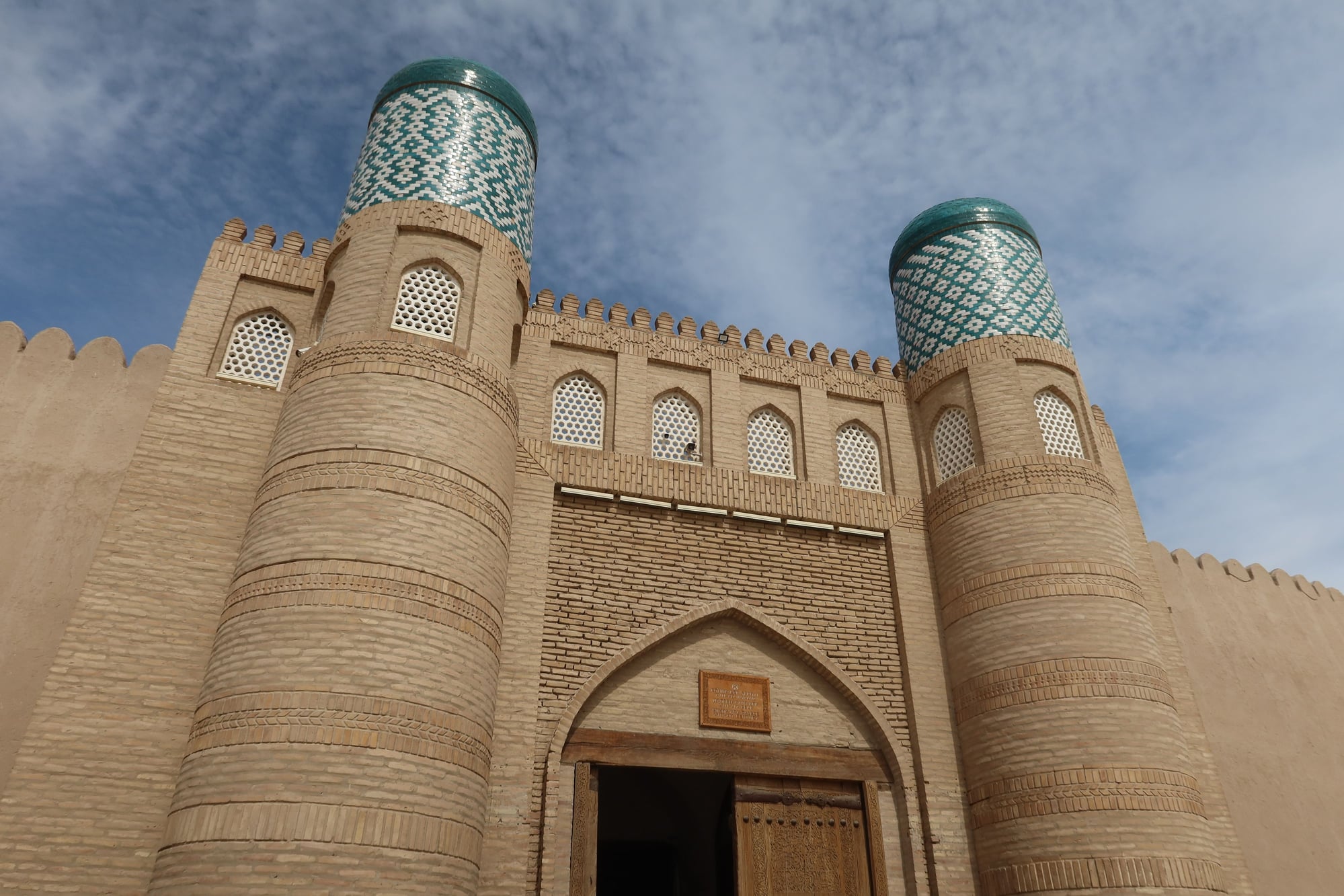
Kuhna Ark
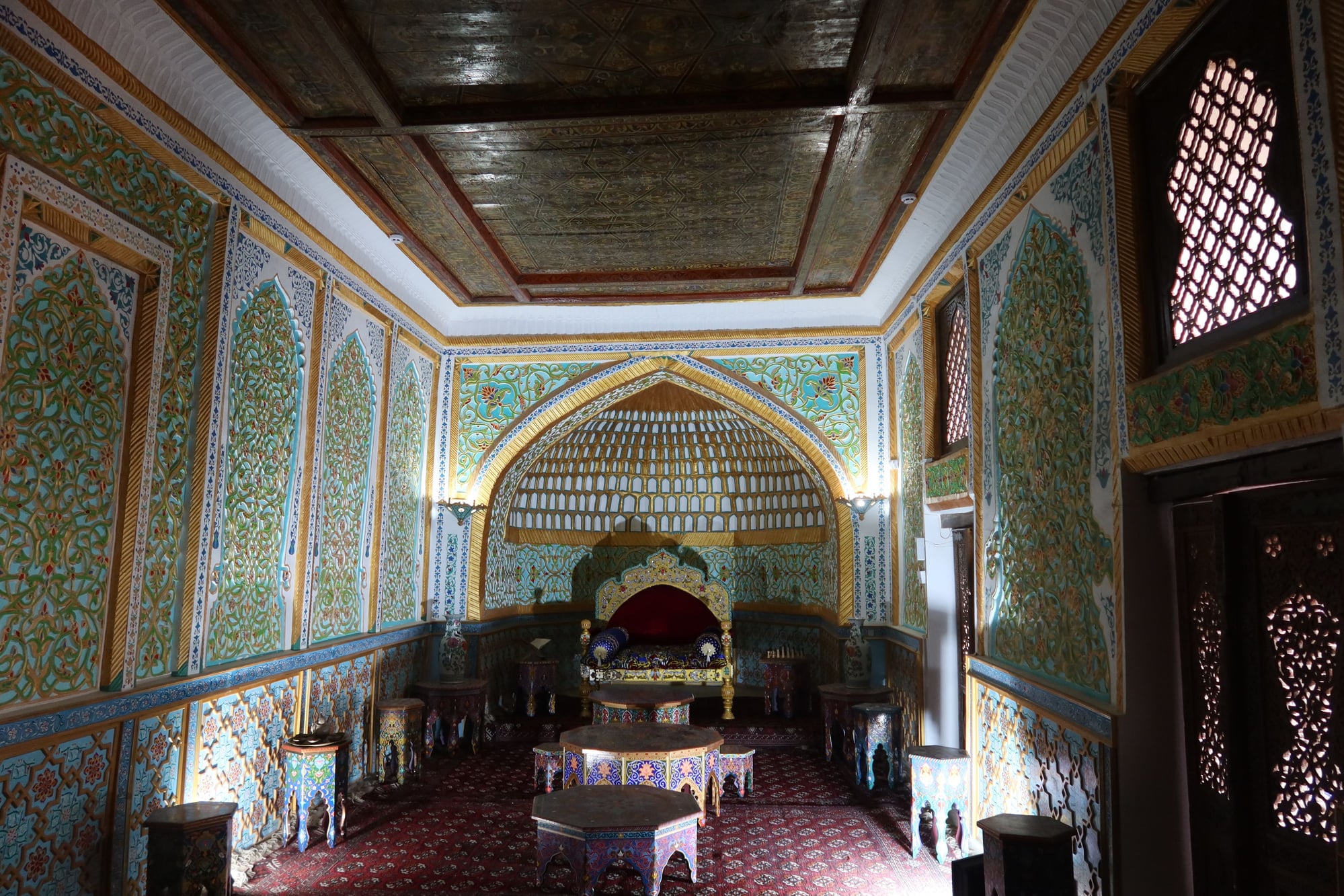
Royal Room in Kuhna Ark
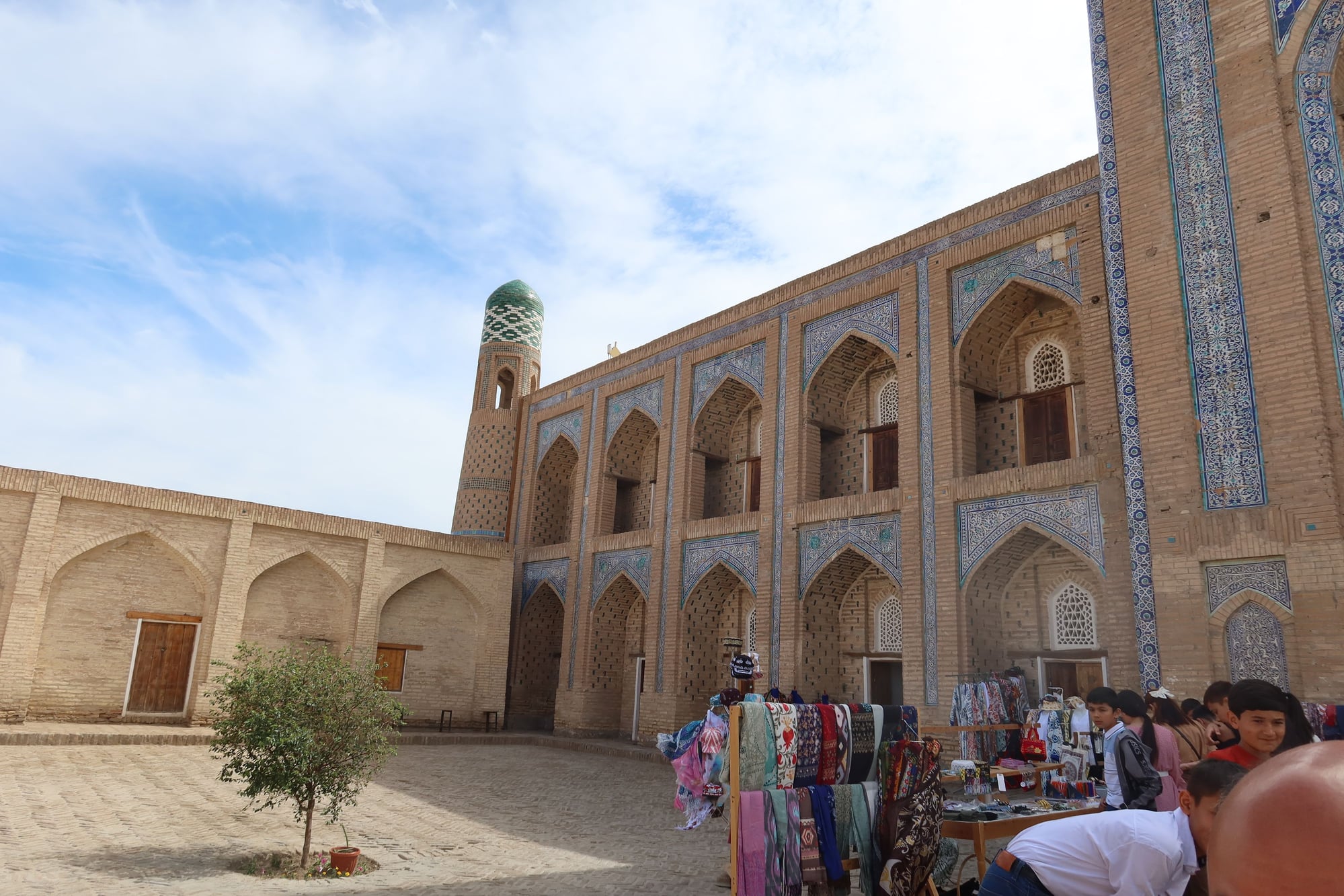
One of the Madrasas
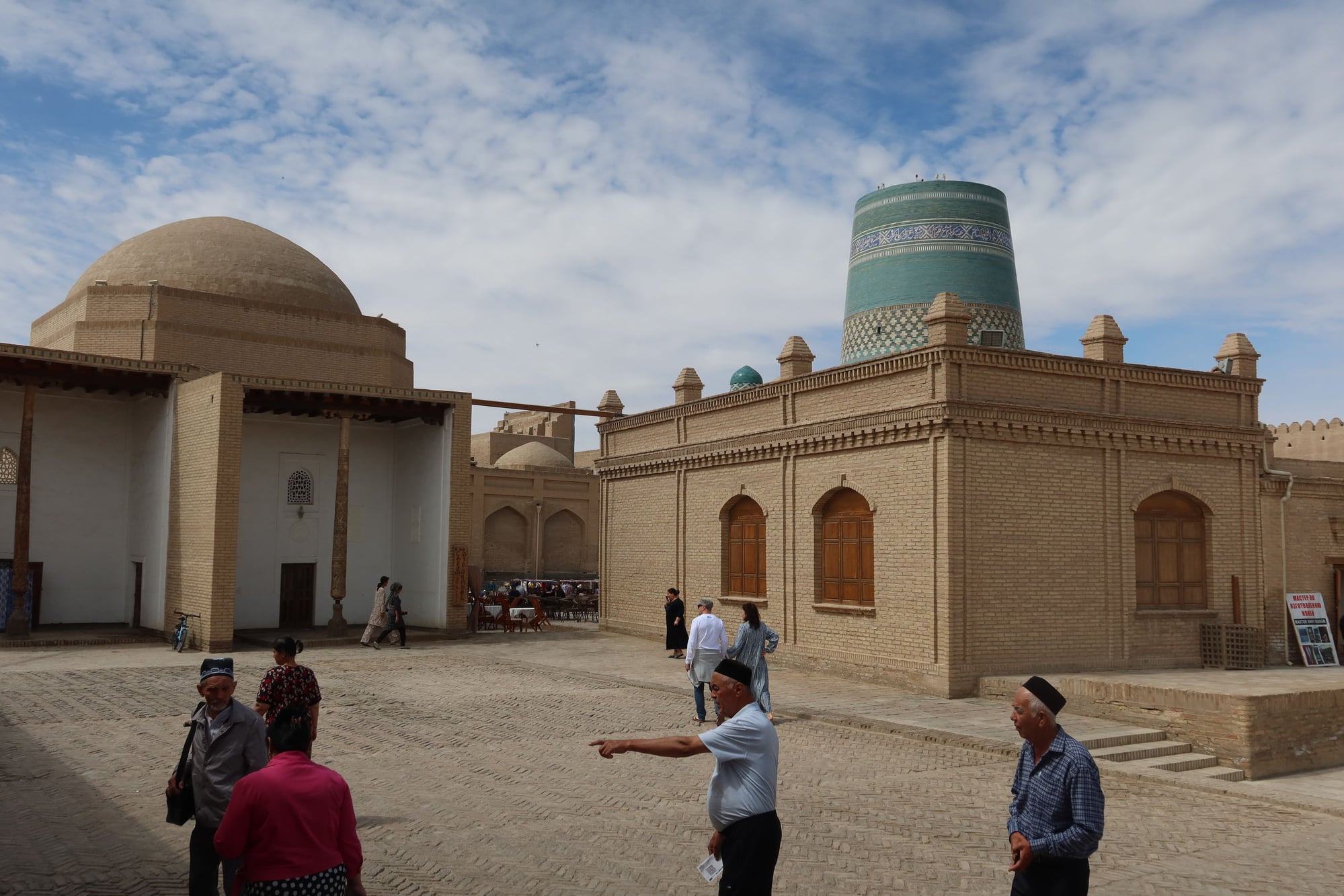
Another Madrasa

Friday Mosque Minaret
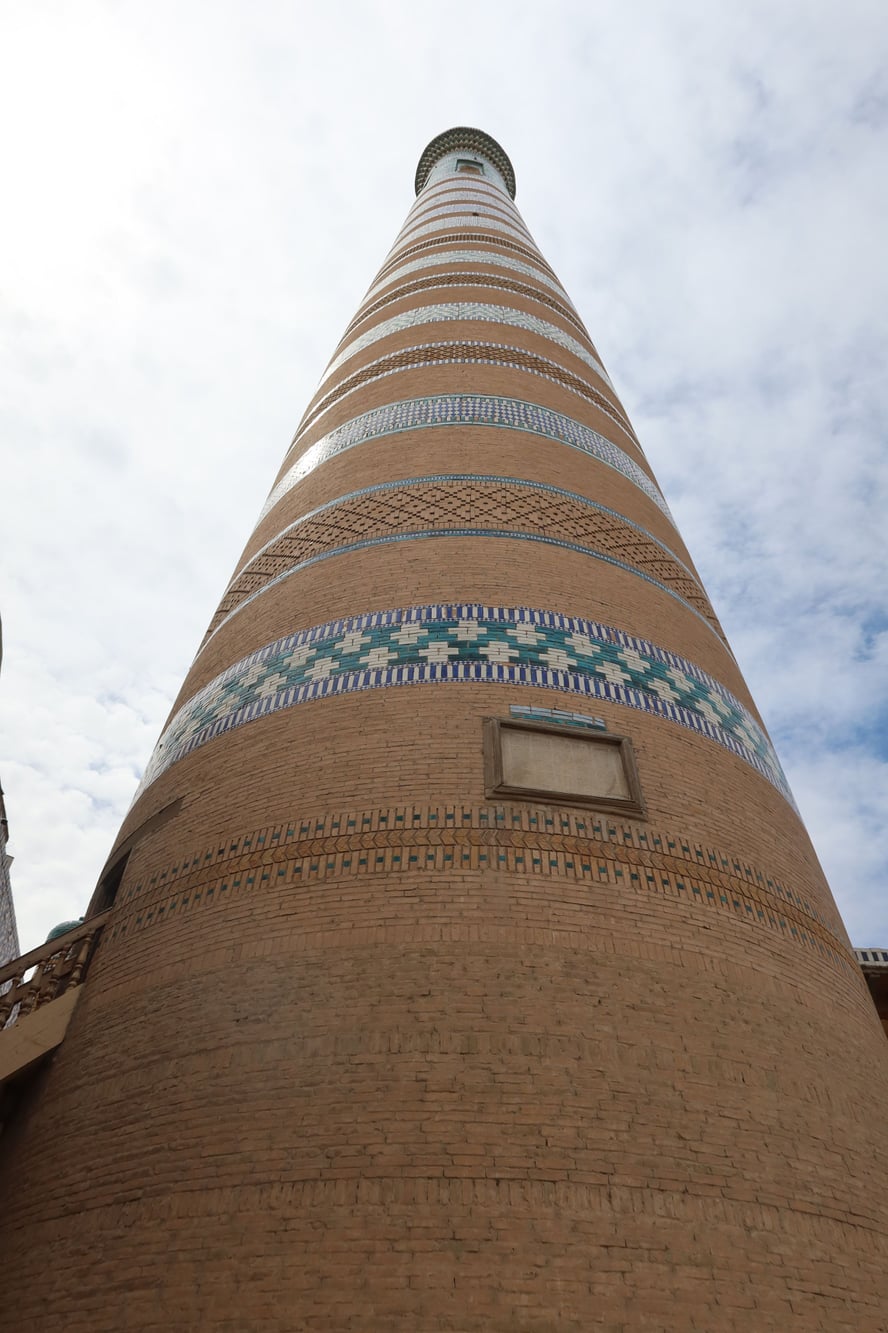
Islam Huja Mosque Minaret (this is the one you can climb to the top)

Pahlavon Mahmud Mausoleum Viewed from Islam Huja Mosque Minaret

Interior Courtyard of Tosh-Hovli Palace
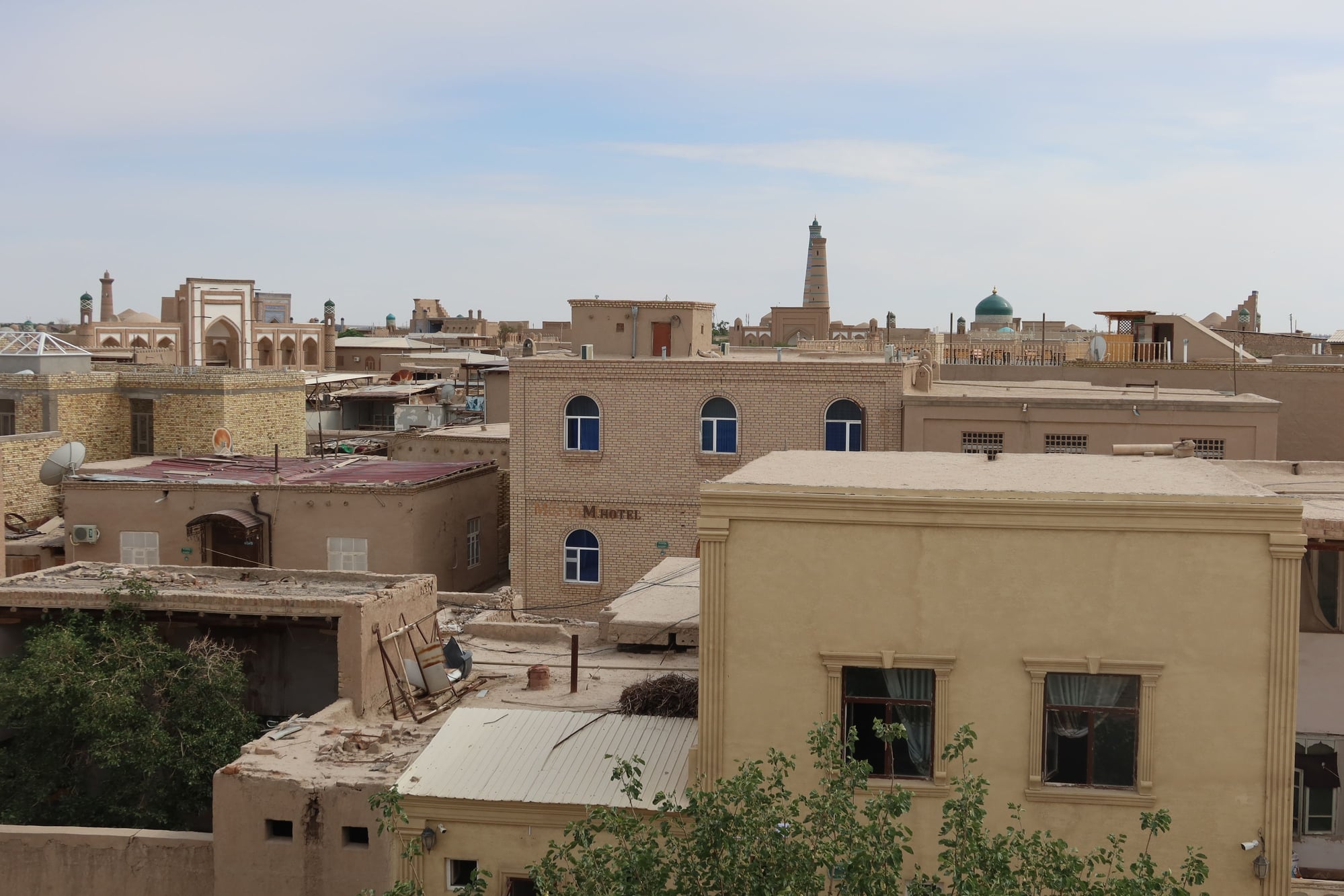
Khiva from the City Walls

A View of the City Walls

Khiva at Night
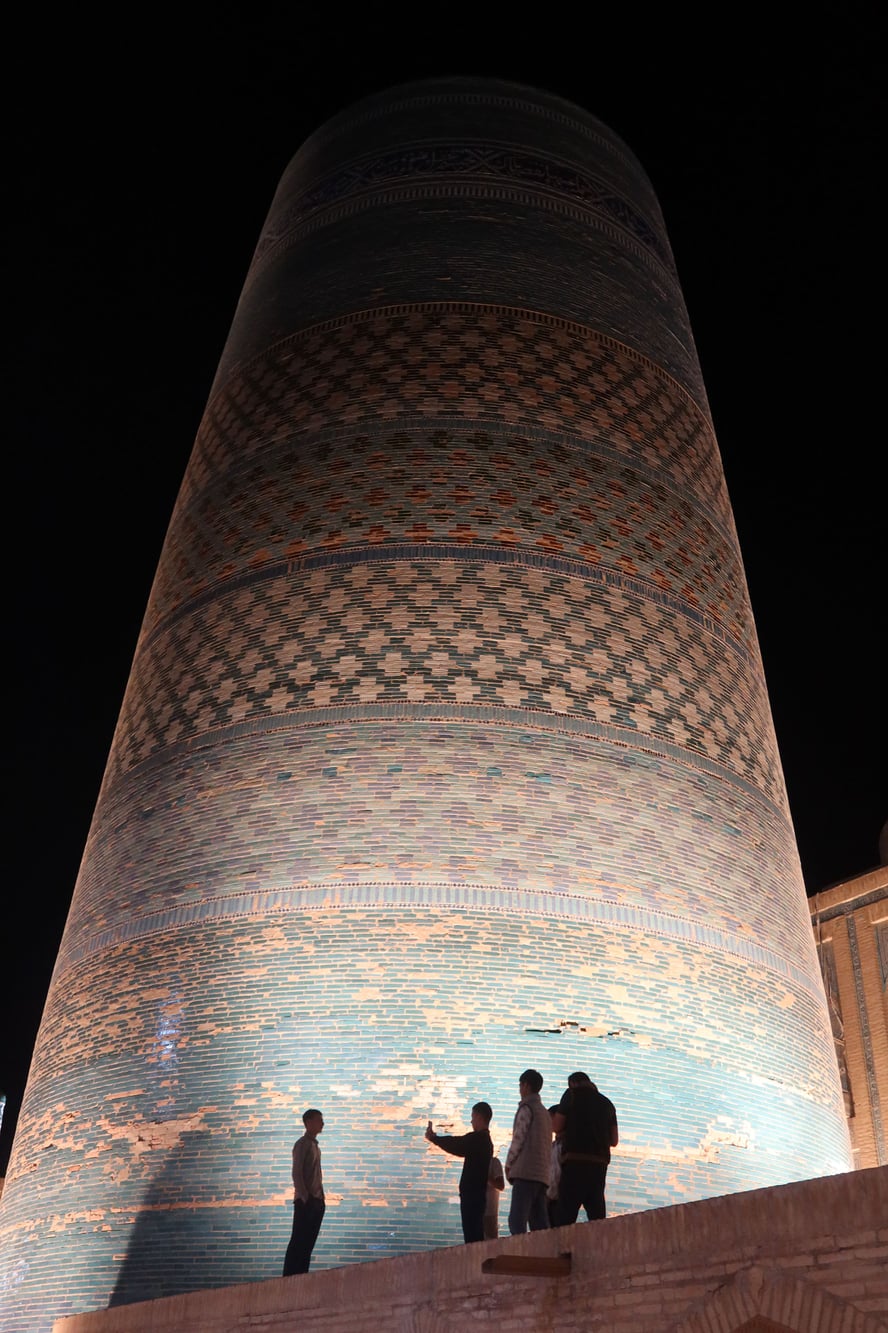
Unfinished Minaret at Night
May 11: Elliq Qala and the Kyzylkum Desert
We left Khiva at 9:00 in the morning bound for our next stop, Bukhara, but via a detour to several of the ancient fortresses across Khorezm, what the region that includes Khiva was known as for millennia. The region contains more than fifty fortresses, hence the name Elliq Qala in the local language. We began our tour at Kabat Qala, a small fortress sitting on top of a rocky outcrop, of which a couple of walls remain standing. Kabat sat at the center of a fertile region that made Khorezm a thriving kingdom in the 11th to 13th centuries.
From there we continued on to Ayaz Qala, a collection of three fortresses sitting atop a large sandy hill. Ayaz was a highlight of the day. We very much enjoyed climbing to the top and then ambling about the fortress walls, surveying the vast desert landscape all around us. As much as we enjoyed the scrambling were the conversations we had with a French couple as well as a group of Japanese tourists about our travels across their beautiful countries. We got to hike and meet other people - what could be better. These are the moments we so much cherish from our travels.
We continued on to Tuprak Qala, the royal residence of the kings of Khorezm. At Toprak is the remains of a palace as well as buildings that once housed the entire royal administration. Also here are remains of the Zoroastrian fire temple. The vistas up top were incredible. At this point, we couldn't decide which we liked better - Tuprak or Ayaz. While we were comparing the fortress, two women from a small group of cultural and arts academics from France joined in. The conversations grew from there, and with more of the group. Soon we were sharing our respective experiences of our journeys across Central Asia thus far. We enjoyed one another so much that we joined them on their tour bus to the next site - Qizil Qala.
Qizil Qala was in a more progressive state of restoration / reconstruction. It gave us a good sense of what these buildings may have looked like two thousand years ago, as well as how it may have been constructed. We toured Qizil with our newfound friends, sharing laughs. After Qizil, we parted ways with one another, the group bound west for Nukus and we southeast towards Bukhara.
Our last fortress of the day was Guldursun Qala, the most restored / reconstructed fortress of the five we visited. We enjoyed a good climb to the top and complete panoramic views of the fortress, although we did not walk around the perimeter as we did the previous three fortresses. While the walls were more or less intact, there was not much else at Guldursun.
From here, it was a six-hour trip to Bukhara (could have been done in five, except we had a slow driver), going through desert for much of the way, arriving at our hotel at 10:00. It was one of our most rewarding days, albeit a very long one. The better option would have been to extend our stay in Khiva for an additional night, visit the fortresses as a day trip, and travel to Bukhara the following day. This was our original plan, until we added Kyrgyzstan to our itinerary and thus leaving us with fewer nights to play around with. Ah, first-world problems.
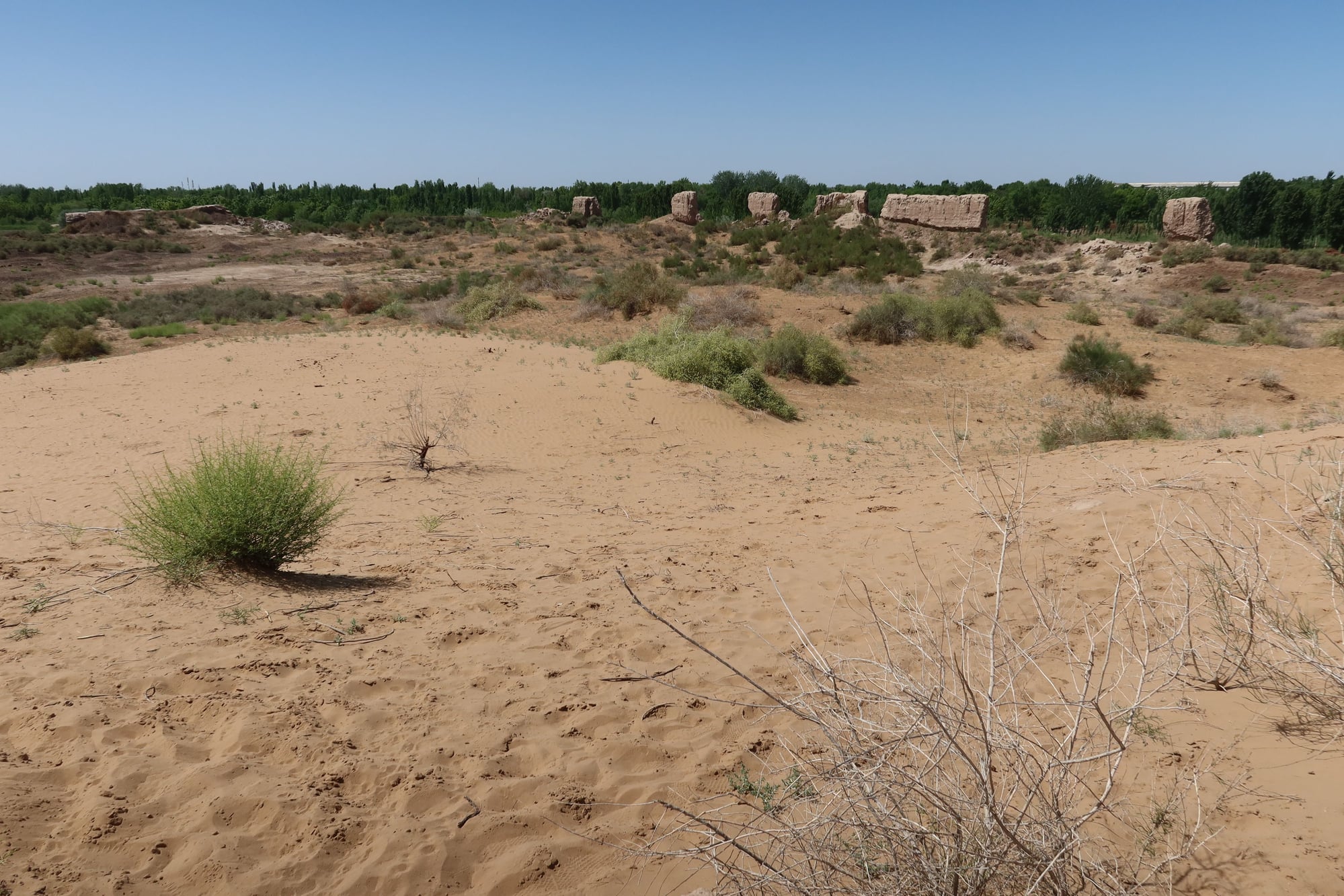
Kabat Qala
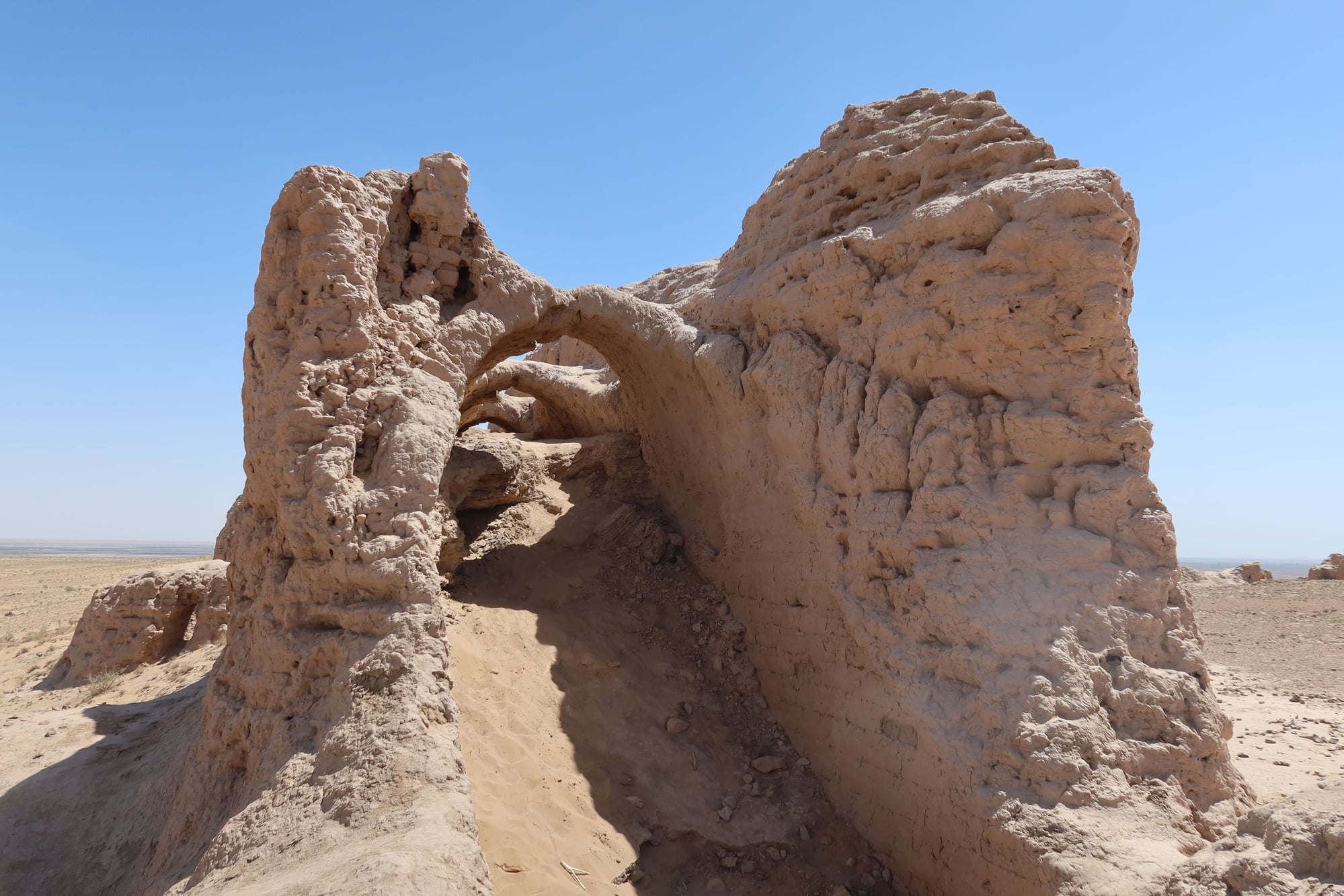
Ayaz Qala

Ayaz Qala

Ayaz Qala

Toprak Qala

Toprak Qala
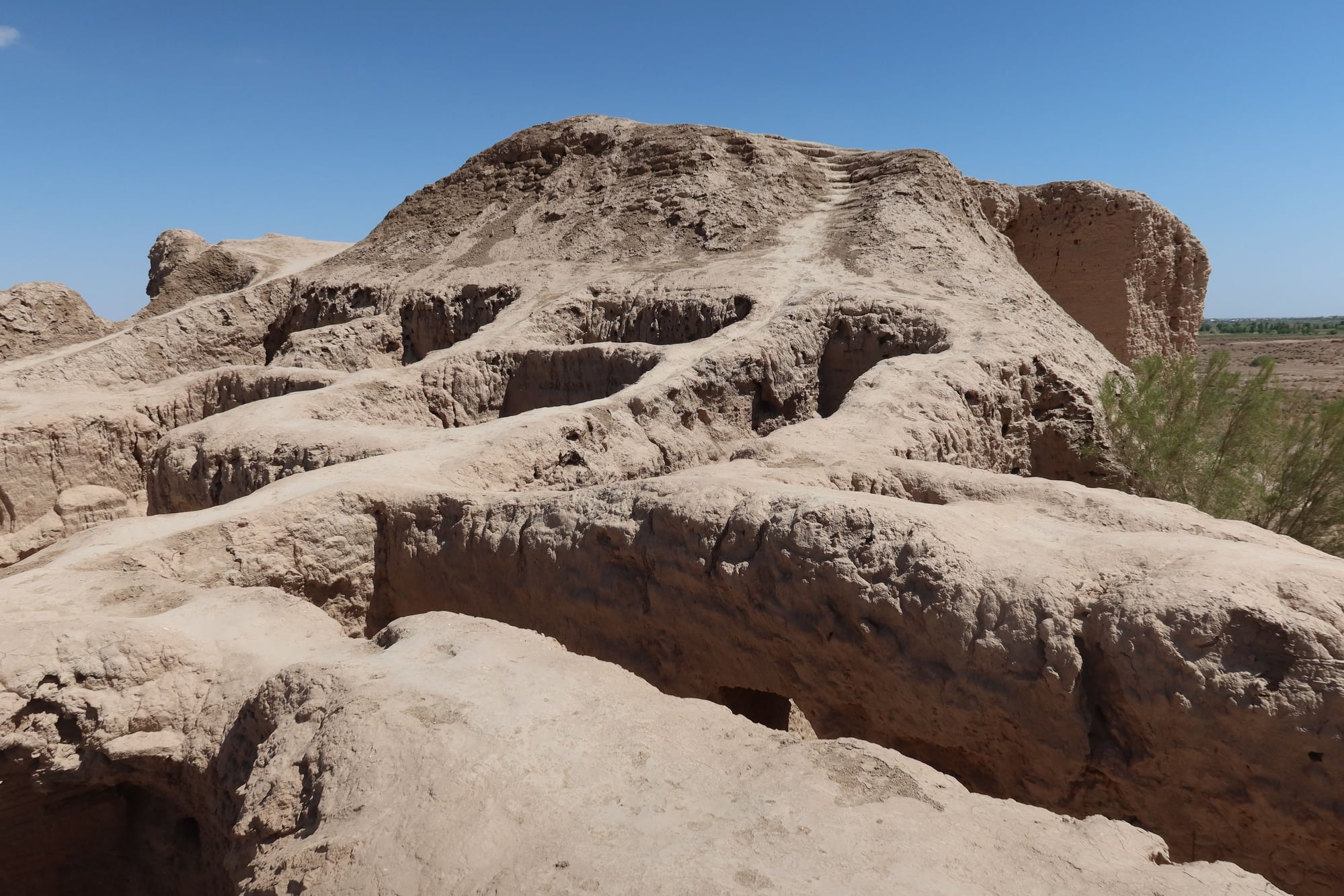
Toprak Qala - Royal Residence

Toprak Qala - Zororastrian Fire Temple
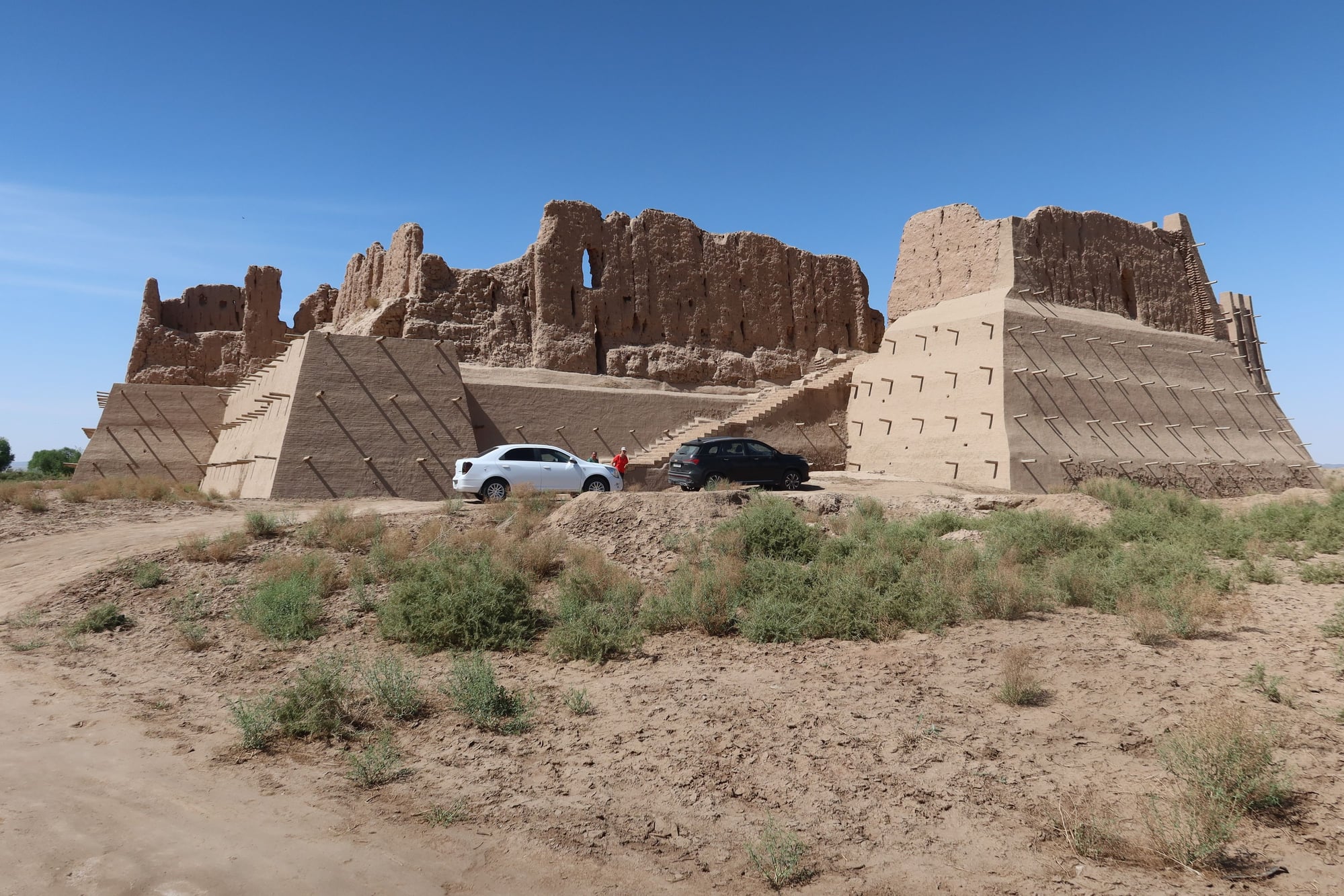
Qizil Qala
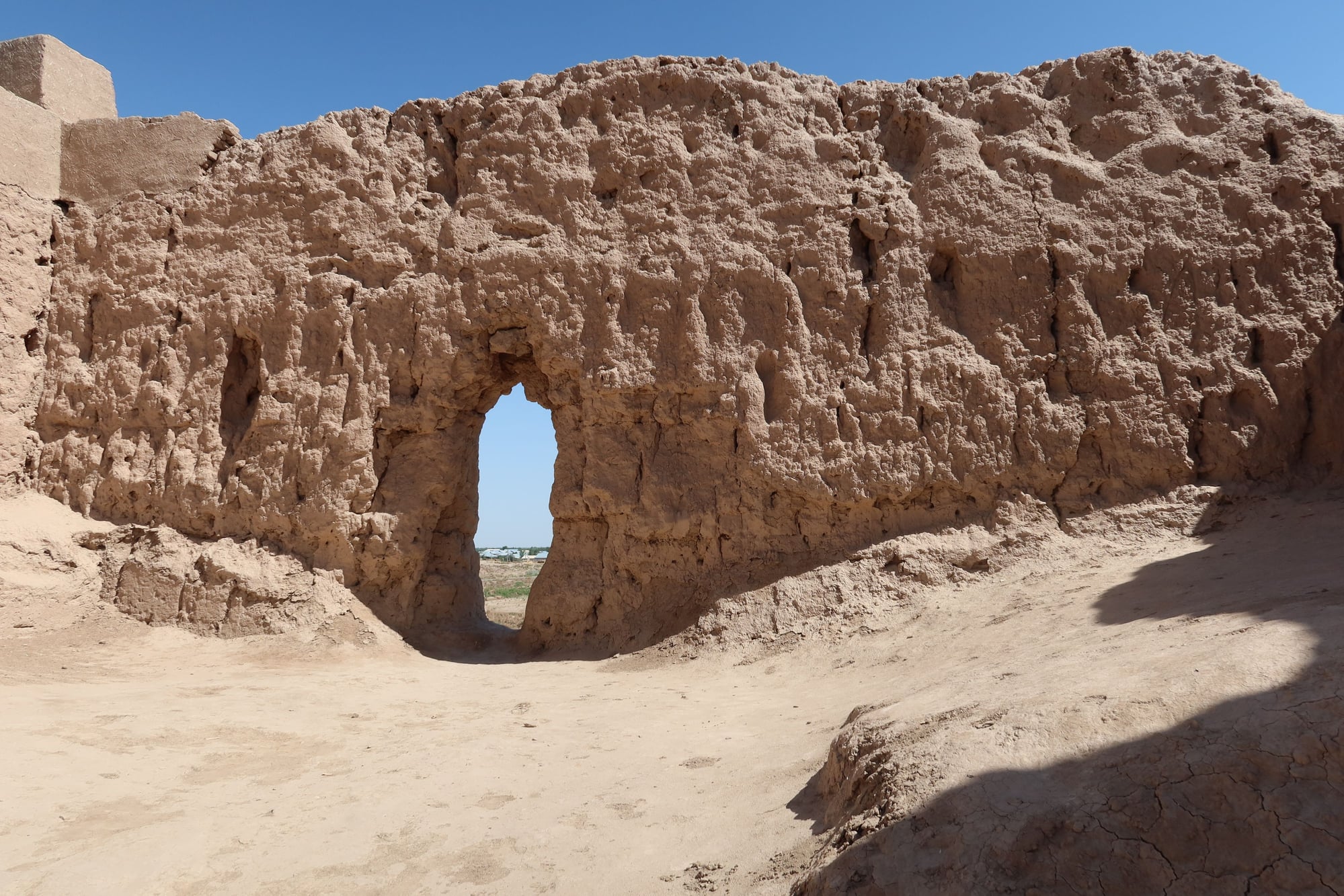
Qizil Qala
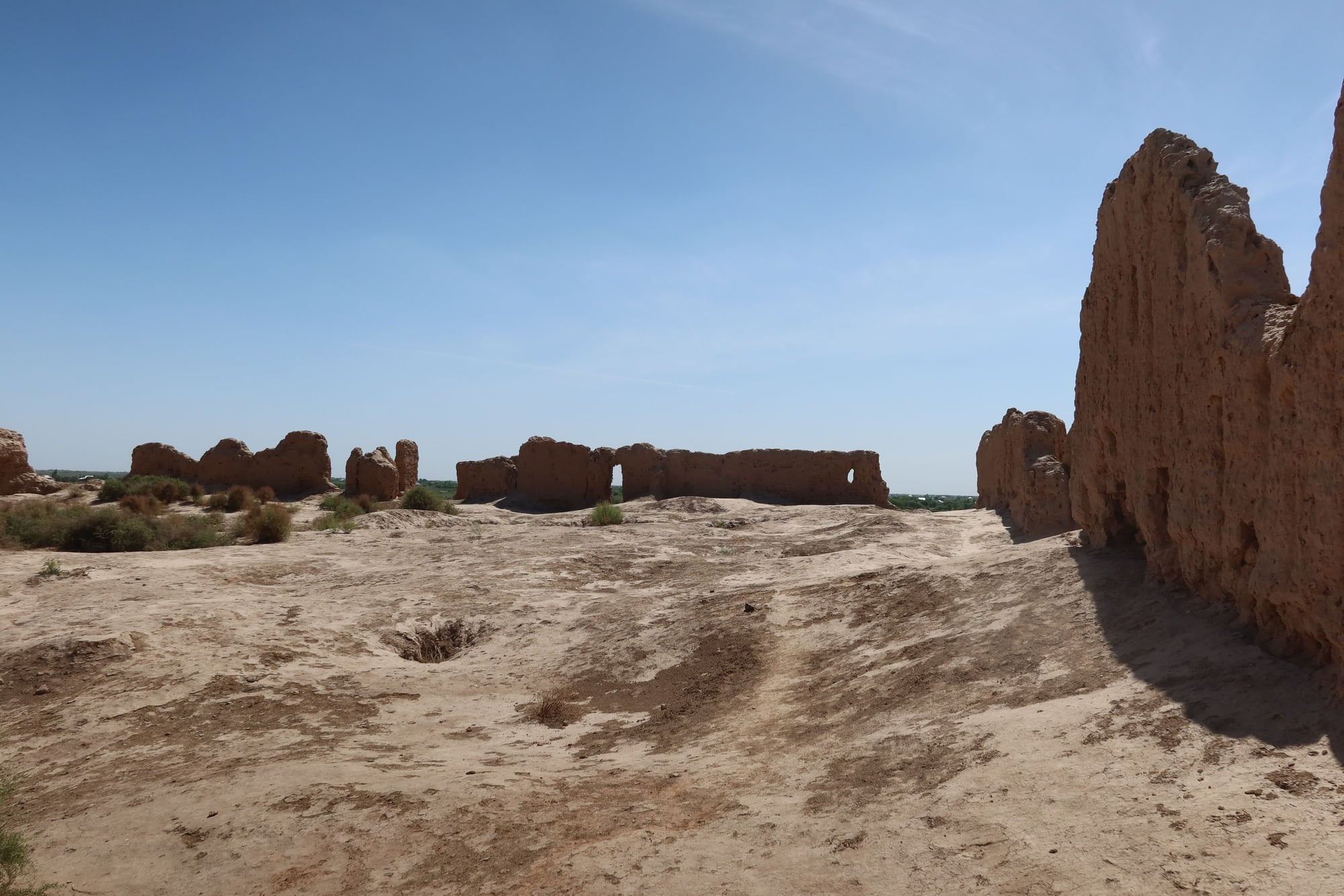
Qizil Qala

Guldursun Qala

Guldursun Qala
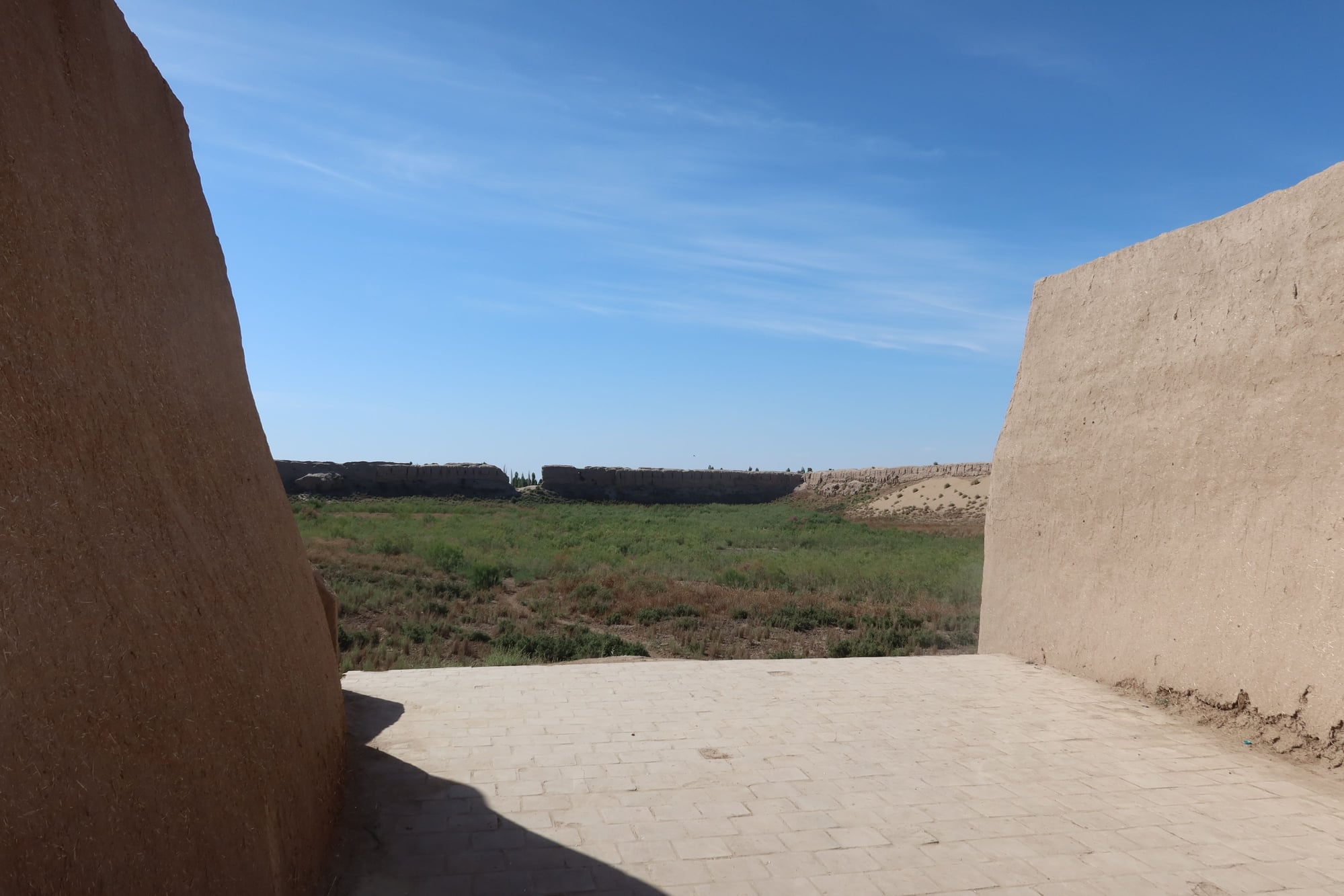
Guldursun Qala
Nelson, thanks for catching that. The missing word is "Parisian".
shelemm, so far, Uzbekistan has most reminded me of our trip to the South Caucasus. Not just as for Soviet republics, but parts of the world with such a mix of history, cultures, and traditions, and yet so little information available. We continue to be pleasantly surprised each and every day.
May 10: Khiva
We flew from Tashkent to Urgench at the crack of dawn this morning. The flight on Uzbekistan Airways, the flagship carrier, was smooth and uneventful. The westward journey took about one and a half hours. From there it was a 40-kilometer taxi ride to Khiva, one of the three most important golden age cities in Uzbekistan.
The early arrival allowed us close to a full day in Khiva (we had originally wanted two nights in Khiva but had to settle with one given our stops elsewhere and the overall time limitations for this trip). We spent all of our time today in the Ichan Qala, the old urban core of historic Khiva. Enclosed by city walls built during its heyday, Khiva was home to numerous madrasas, mosques, and places of commerce, as well as residences. While some people still live within these old city walls, its entire existence today is dependent upon tourism. This could not be more evident than today.
Walking from our hotel, the Hotel Bankir, a small, simple hotel a few minutes by foot from the West Gate into Old Khiva, we eagerly anticipated the place we were about to visit and were immediately impressed upon the site of the brown fortress walls and the distinctive unfinished minaret. However the feelings of wonder and happiness quickly turned to anxiety as we saw the deluge of tour buses and tour groups that were about to descend onto the site as well as those who were already in. In our minds, Khiva was still off the beaten path, but apparently not. There were so many groups, large and small, that we lost count. Throughout the day, we heard and saw English-, French-, Spanish-, Italian-, German-, Chinese-, and Korean-speaking groups. Had we known, we may have been more strategic? But who would’ve thought? Oh well. We only had a day here, and there’s nothing we could have done but make the most out of it. The crowds were the worst from when we arrived, around 9:45, until about noon.
We started our visit from the West Gate, made our way along the main street to the East Gate while wandering among some of the side streets, and ended at the North Gate. We visited more than a dozen madrasas, mausoleums, and mosques, and browsed some of the souvenir shops. Stepping into the Ichan Qala was like stepping back in time. I imagined what it must have been like walking the ancient streets in the several hundred years when Khiva was ruled by the khans, following the Mongols until the arrival of the Russians. The buildings towered over me both left and right. The madrasas were especially huge, with the front entrance portals beautifully decorated. Each are rectangular buildings with a courtyard in the interior and doors leading to rooms all around the perimeter. Also massive was the Persian-style Pahlavon Mahmud Mausoleum, which houses the tombs of some of Khiva’s most important rulers. This reminded me of the Saadian Tombs in Marrakesh.
Most of the buildings are brown, with a mix of brick, mud, and straw, and decorated with geometric patterns in every shade of blue you could imagine and Arabic calligraphy. Often the colors would come as a surprise. All we would see is brown everywhere, then we enter a door or make a turn, and we would see a riot of blues. Two examples of this were at the Kuhna Ark and the Tosh-Hovli Palace, both used by Khiva’s rulers.
Standing like beacons towering over Khiva are three minarets, one belong to the Friday Mosque, another to the Islam Huja Mosque and Madrasa, and the third the unfinished minaret near the West Gate. The unfinished minaret had a massive base and would probably have been at least twice as tall as the one at Islam Huja had it been completed; the building stopped when the patron ruler died. The one at Friday Mosque is a simple structure, matching the Mosque next to where it stands. Islam Huja's Minaret is accessible to visitors; the climb up is fairly difficult as the passageway is narrow and the stairs are so steep that we had to semi-crawl up and down. The views at the top, across the rooftops of Old Khiva, are spectacular though.
Equally as impressive are the walls that surround the old city. Accessed from the North Gate, we could only walk to and back the West Gate and to and back the East Gate, as this is the only section that was restored for visits. The views from up here were just as good. While we surveyed across a wide distance from Islam Huja, we enjoyed close-up views of the buildings from the walls. The stairs to get up to the walls were also steep, but it's at least only a handful.
We spent about seven hours inside the old town, and felt we had seen all that we wanted to see. Several of the madrasas as well as other large, public spaces housed small museums - several interesting, others not so much. We most enjoyed the ones that exhibited the history of Khiva over the different ages of empires, the one of the local costumes, and the one featuring Uzbek art. There were museums housing profiles of religious scholars, one on coinage used over the years, etc. Except for 2 or 3 sites, all the entrance fees are covered by the entrance ticket to the old town.
We returned to the fortress after a satisfying dinner at the beautiful patio at Khiva Moon near our hotel, and were glad we did. The place has a very different atmosphere and feel after dark. The fortress walls were lit up, as were several of the landmark buildings and minarets. Strolling down the main thoroughfare, viewing what makes Khiva Khiva, and ice cream in hand - a perfect way to end a long day.

West Gate

Main Thoroughfare with Unfinished Minaret

Kuhna Ark

Royal Room in Kuhna Ark

One of the Madrasas

Another Madrasa

Friday Mosque Minaret

Islam Huja Mosque Minaret (this is the one you can climb to the top)

Pahlavon Mahmud Mausoleum Viewed from Islam Huja Mosque Minaret

Interior Courtyard of Tosh-Hovli Palace

Khiva from the City Walls

A View of the City Walls

Khiva at Night

Unfinished Minaret at Night
May 11: Elliq Qala and the Kyzylkum Desert
We left Khiva at 9:00 in the morning bound for our next stop, Bukhara, but via a detour to several of the ancient fortresses across Khorezm, what the region that includes Khiva was known as for millennia. The region contains more than fifty fortresses, hence the name Elliq Qala in the local language. We began our tour at Kabat Qala, a small fortress sitting on top of a rocky outcrop, of which a couple of walls remain standing. Kabat sat at the center of a fertile region that made Khorezm a thriving kingdom in the 11th to 13th centuries.
From there we continued on to Ayaz Qala, a collection of three fortresses sitting atop a large sandy hill. Ayaz was a highlight of the day. We very much enjoyed climbing to the top and then ambling about the fortress walls, surveying the vast desert landscape all around us. As much as we enjoyed the scrambling were the conversations we had with a French couple as well as a group of Japanese tourists about our travels across their beautiful countries. We got to hike and meet other people - what could be better. These are the moments we so much cherish from our travels.
We continued on to Tuprak Qala, the royal residence of the kings of Khorezm. At Toprak is the remains of a palace as well as buildings that once housed the entire royal administration. Also here are remains of the Zoroastrian fire temple. The vistas up top were incredible. At this point, we couldn't decide which we liked better - Tuprak or Ayaz. While we were comparing the fortress, two women from a small group of cultural and arts academics from France joined in. The conversations grew from there, and with more of the group. Soon we were sharing our respective experiences of our journeys across Central Asia thus far. We enjoyed one another so much that we joined them on their tour bus to the next site - Qizil Qala.
Qizil Qala was in a more progressive state of restoration / reconstruction. It gave us a good sense of what these buildings may have looked like two thousand years ago, as well as how it may have been constructed. We toured Qizil with our newfound friends, sharing laughs. After Qizil, we parted ways with one another, the group bound west for Nukus and we southeast towards Bukhara.
Our last fortress of the day was Guldursun Qala, the most restored / reconstructed fortress of the five we visited. We enjoyed a good climb to the top and complete panoramic views of the fortress, although we did not walk around the perimeter as we did the previous three fortresses. While the walls were more or less intact, there was not much else at Guldursun.
From here, it was a six-hour trip to Bukhara (could have been done in five, except we had a slow driver), going through desert for much of the way, arriving at our hotel at 10:00. It was one of our most rewarding days, albeit a very long one. The better option would have been to extend our stay in Khiva for an additional night, visit the fortresses as a day trip, and travel to Bukhara the following day. This was our original plan, until we added Kyrgyzstan to our itinerary and thus leaving us with fewer nights to play around with. Ah, first-world problems.

Kabat Qala

Ayaz Qala

Ayaz Qala

Ayaz Qala

Toprak Qala

Toprak Qala

Toprak Qala - Royal Residence

Toprak Qala - Zororastrian Fire Temple

Qizil Qala

Qizil Qala

Qizil Qala

Guldursun Qala

Guldursun Qala

Guldursun Qala
#16
> The missing word is "Parisian"
Thanks, that's one I would not have guessed, but now it makes sense.
Those desert forts are fascinating, and your photos do them justice. Decades ago, probably in my teens, I read a Sven Hedin book that gave me an interest in this mysterious region. You must be cross his route. Safe travels!
Thanks, that's one I would not have guessed, but now it makes sense.
Those desert forts are fascinating, and your photos do them justice. Decades ago, probably in my teens, I read a Sven Hedin book that gave me an interest in this mysterious region. You must be cross his route. Safe travels!
#17
Original Poster
Join Date: Sep 2012
Posts: 3,158
Likes: 0
Received 0 Likes
on
0 Posts
shelemm, you're absolutely right. There were definitely a few instances in which I had to do some close examination to distinguish what is natural and what was manmade, especially at Toprak.
Nelson, you're welcome. Now I may check out the book when I get back.
May 12: Bukhara
Happy Mother’s Day. We’re now in the fabled city of Bukhara. Bukhara sat at a nexus of sorts of the Silk Road, with China to the East, India to the South, Persia and the Arab World to the southwest, and Europe to the northwest. It was a place where goods as well as ideas exchanged hands. As such, the city was once a major center of learning, culture, arts and crafts, as well as commerce. Today we play the role of modern-day Silk Road travelers, especially as we wandered some of the lanes, thoroughfares, and markets all around the city.
We began the day with breakfast at our hotel, Alexia Suites, which is a beautifully-appointed and comfortable boutique hotel just a block away from Lab-i-Hauz. The courtyard style building with its decorative focal points would be right at home in Fez and Marrakesh, and really brought back wonderful memories of our trip there in 2021. The only downside, the hotel only accepted cash payment, and this was not made clear at the time of booking.
Our visit of the old city center started at Chor Minor, an unique mosque with four minaret build directly on the roof of the place of worship instead of next to or nearby it. Each of the four minarets sported different designs, including one featuring a nest with two storks. From here we headed back west to Lab-i-Hauz with its three buildings: Nadir Divan-Beghi Madrasa on the east side, Kukeldash Madrasa on the north, and Nadir Divan-Beghi Khankah on the west. The façade of Nadir Divan-Beghi Madrasa is spectacular with its Persian-style decorations featuring flowers, animals, geometric shapes, and calligraphy, all in different shades of blue and turquoise. The madrasa houses a small museum depicting how the space was once used as a school and residence while the rest of the many spaces have been taken over by souvenir shops hawking typical tourist ware. The same goes for Kukeidash Madrasa and the Kkankah, although both are clothed in much more subtle colors and ornamentation.
We continued west to the city’s numerous covered bazaars: the moneychangers’ bazaar, the capmakers’ bazaar, and the jewellers’ bazaar. Today, you guessed it: it’s been fully invaded and occupied by vendors selling tourist chum. Think T-shirts, key rings, decorative plates, ceramics, and the like. Despite the subject of today’s business, I enjoyed the atmosphere in this area. Wandering among the stalls and along the streets with its buildings from yesteryear, I cannot help but feel transported back in time several centuries. Near the bazaars are two very important and grandiose buildings: Ulugbek Madrasa and Abdul Aziz Khan Madrasa. Each house small museums but are mostly occupied by souvenir shops. Not too far from the madrasas and the bazaars is Kalyan Mosque, with its minaret. Another mosque that would feel right at home in Persia, Kalyan featured hundreds of columns connected by arches. We wandered and got “lost” among the rows and rows of columns.
Not far from here is the Ark, the former residence of the ruling emirs of Bukhara. The exhibits here are fine-ish, but the views over the city are awesome. We also visited nearby Bolo Khaouz Mosque, Chashma Ayub Mausoleum, and the Samanid Mausoleum. Sprinkled throughout the day were also shopping and visits to a couple of teahouses to sip our beverages of choice and soak in the ambiance of a different era.
While I’ve never have had the opportunity to visit Iran, I have developed a romanticized image of the cities of Shiraz and Isfahan. At different points throughout the day today, those images kept on popping up in my head over and over again. I kept on wondering to myself, “Is this what Isfahan feels like?” In any case, I find myself falling in love with the refined, genteel character of the city. It’s one I wouldn’t mind lingering in for a bit longer.

Chor Minor
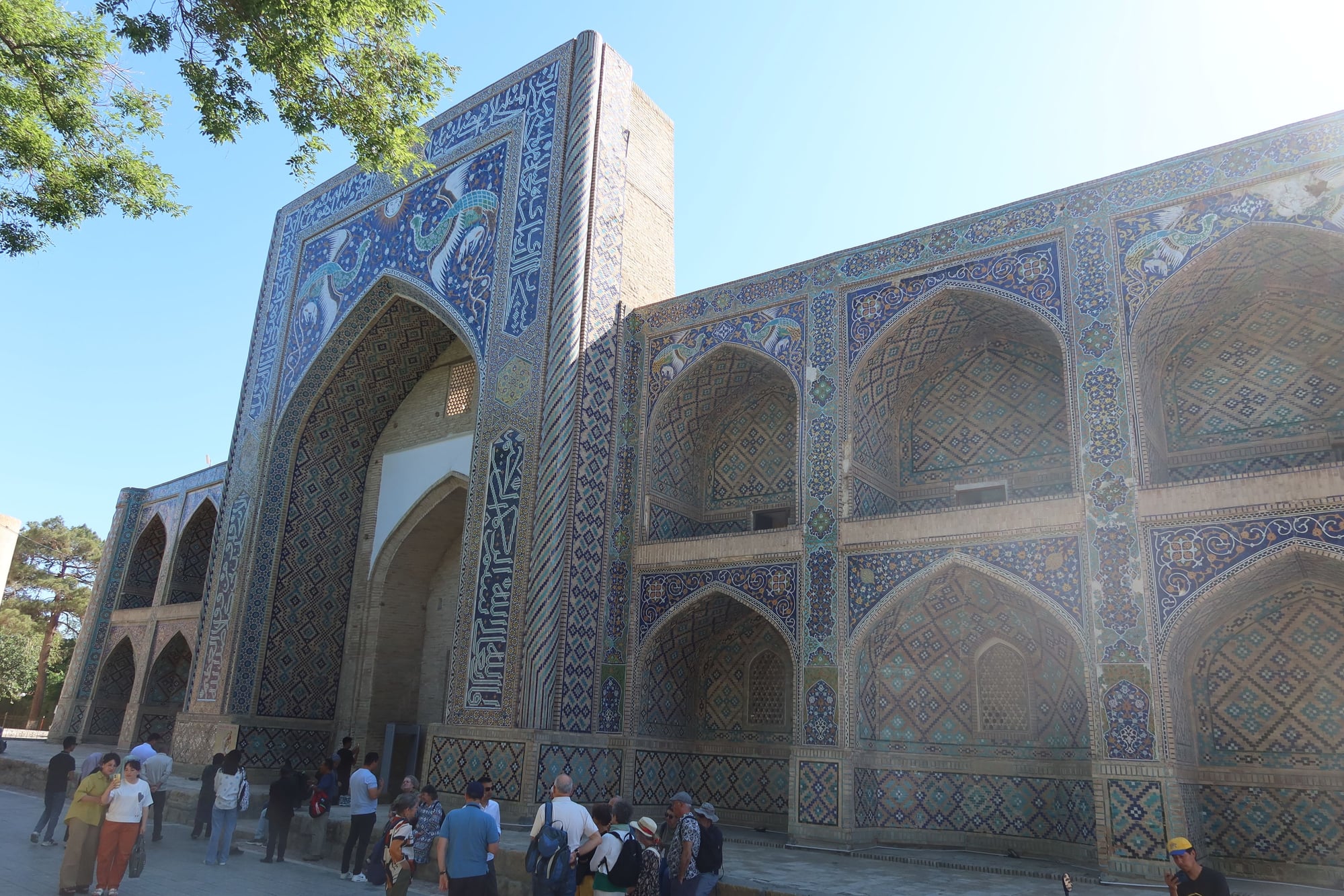
Nadir Divan-Beghi Madrasa
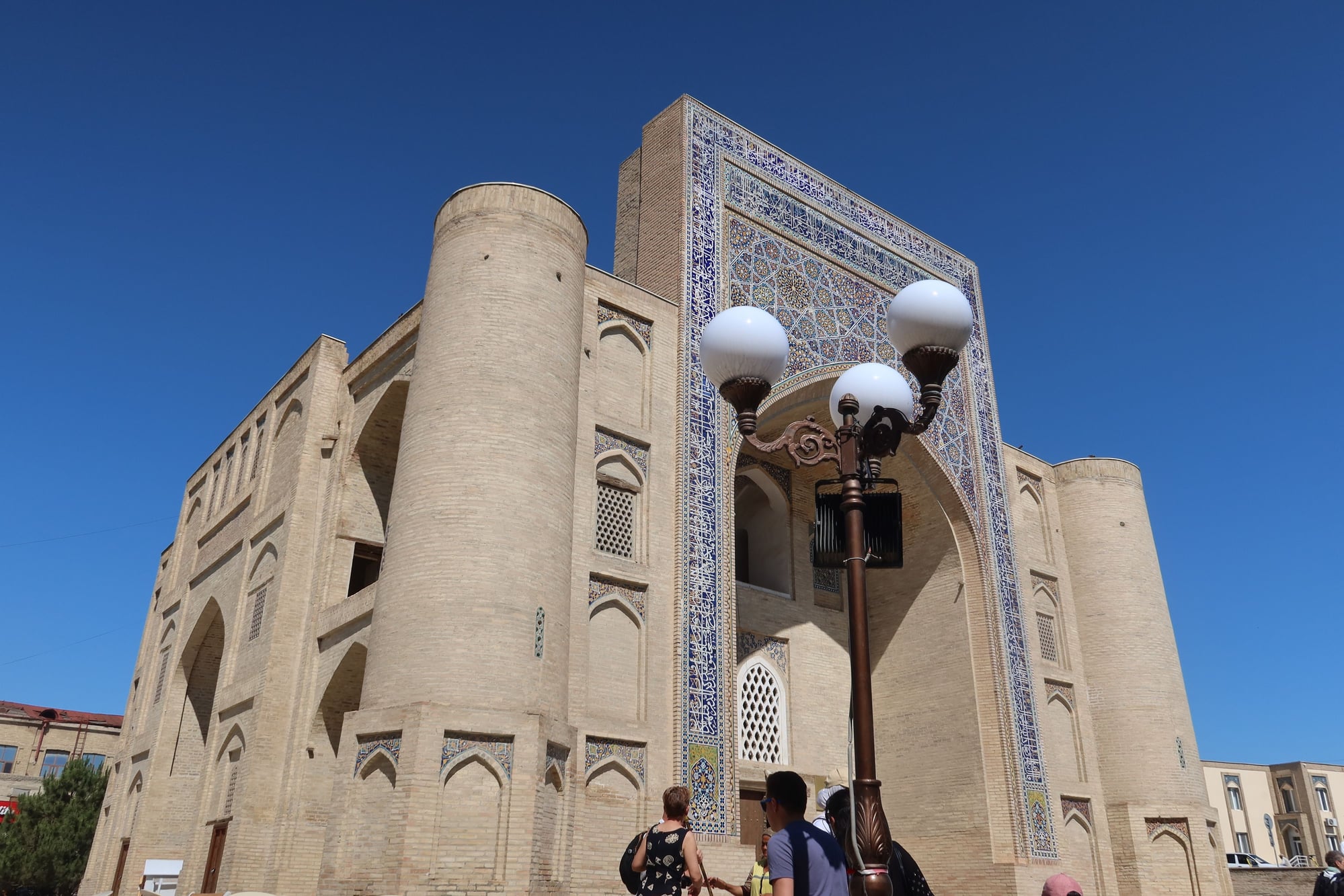
Nadir Divan-Beghi Khankah
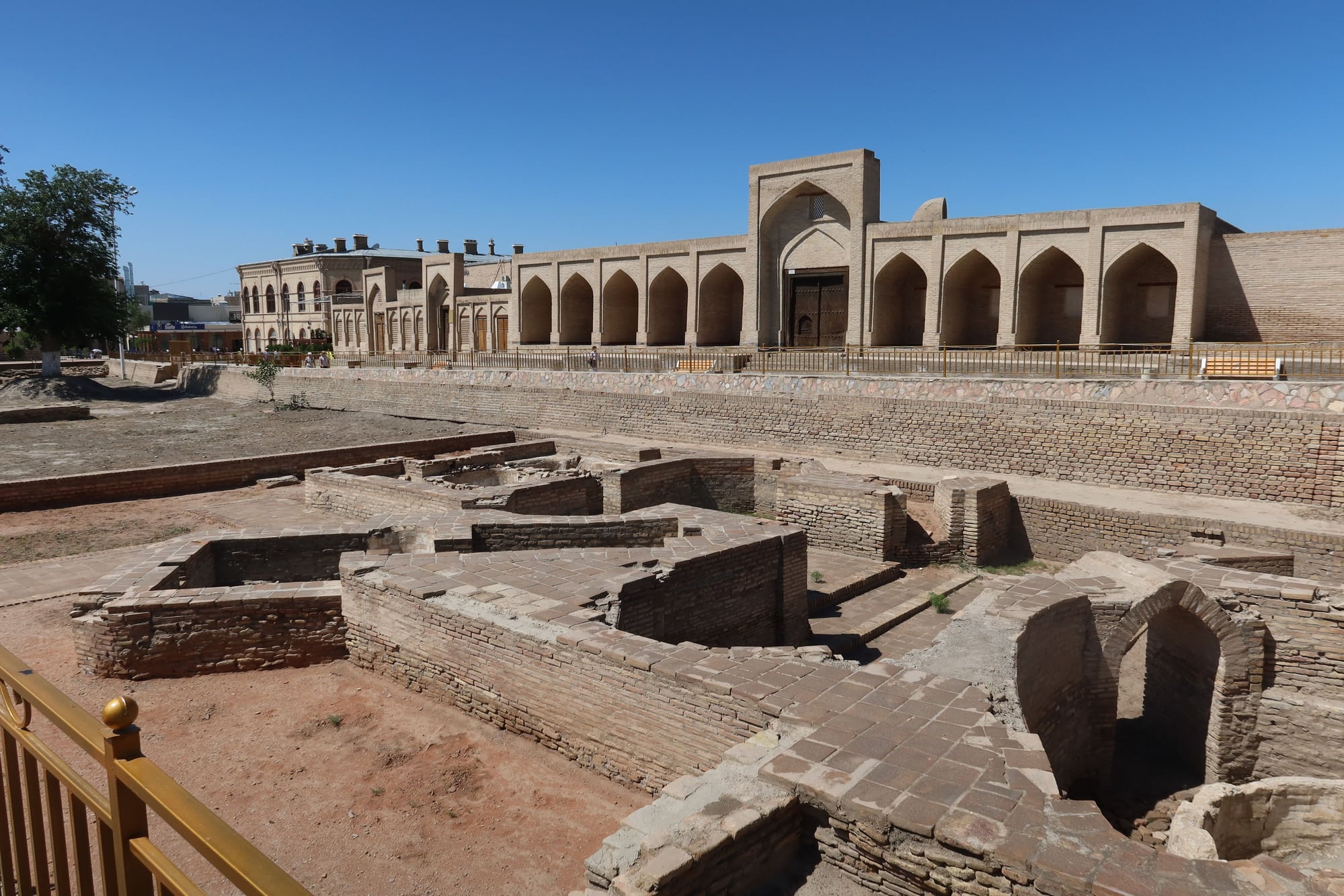
Old Caravanserai

Abdul Aziz Khan Madrasa
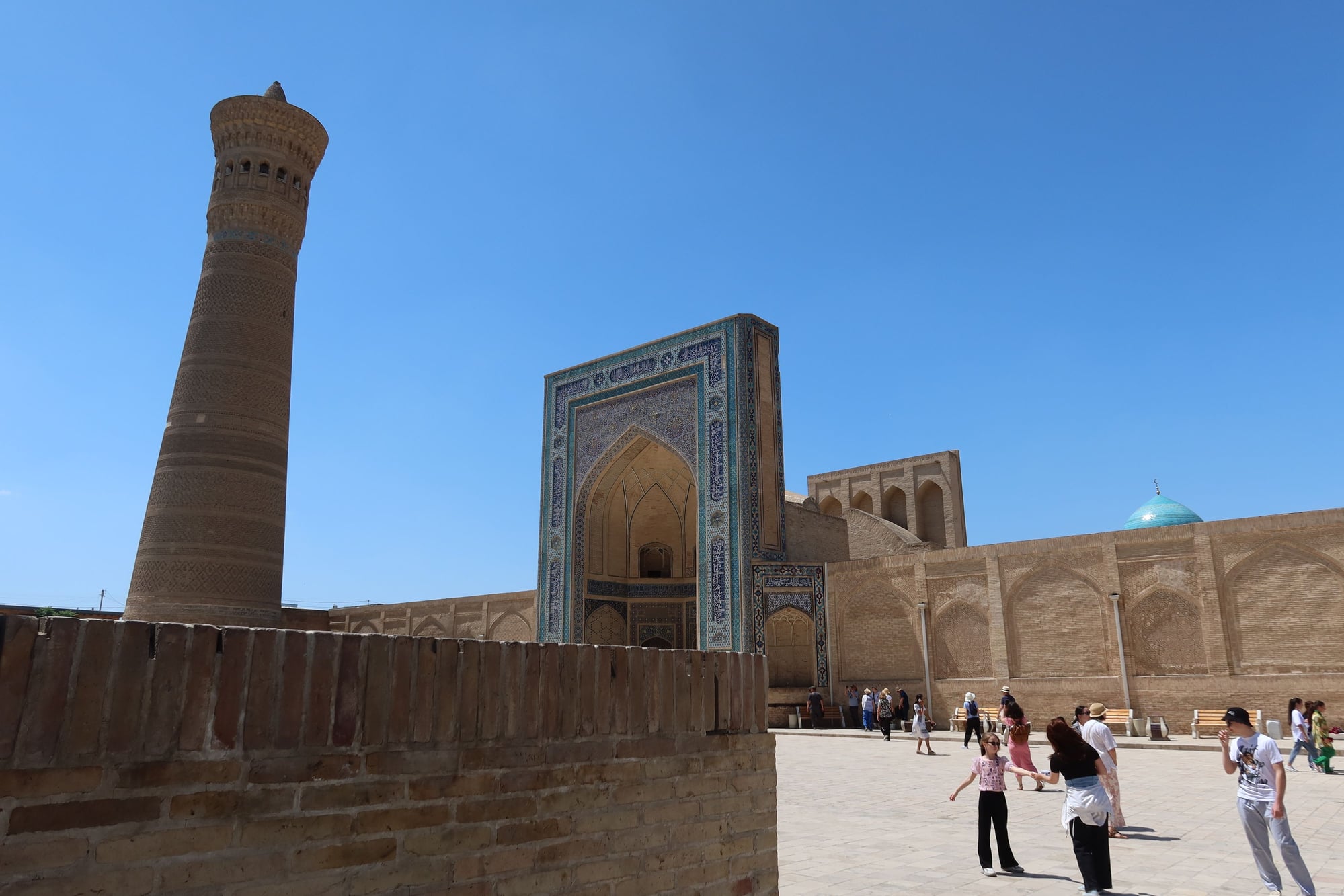
Kalyan Mosque and Minaret

Kalyan Mosque
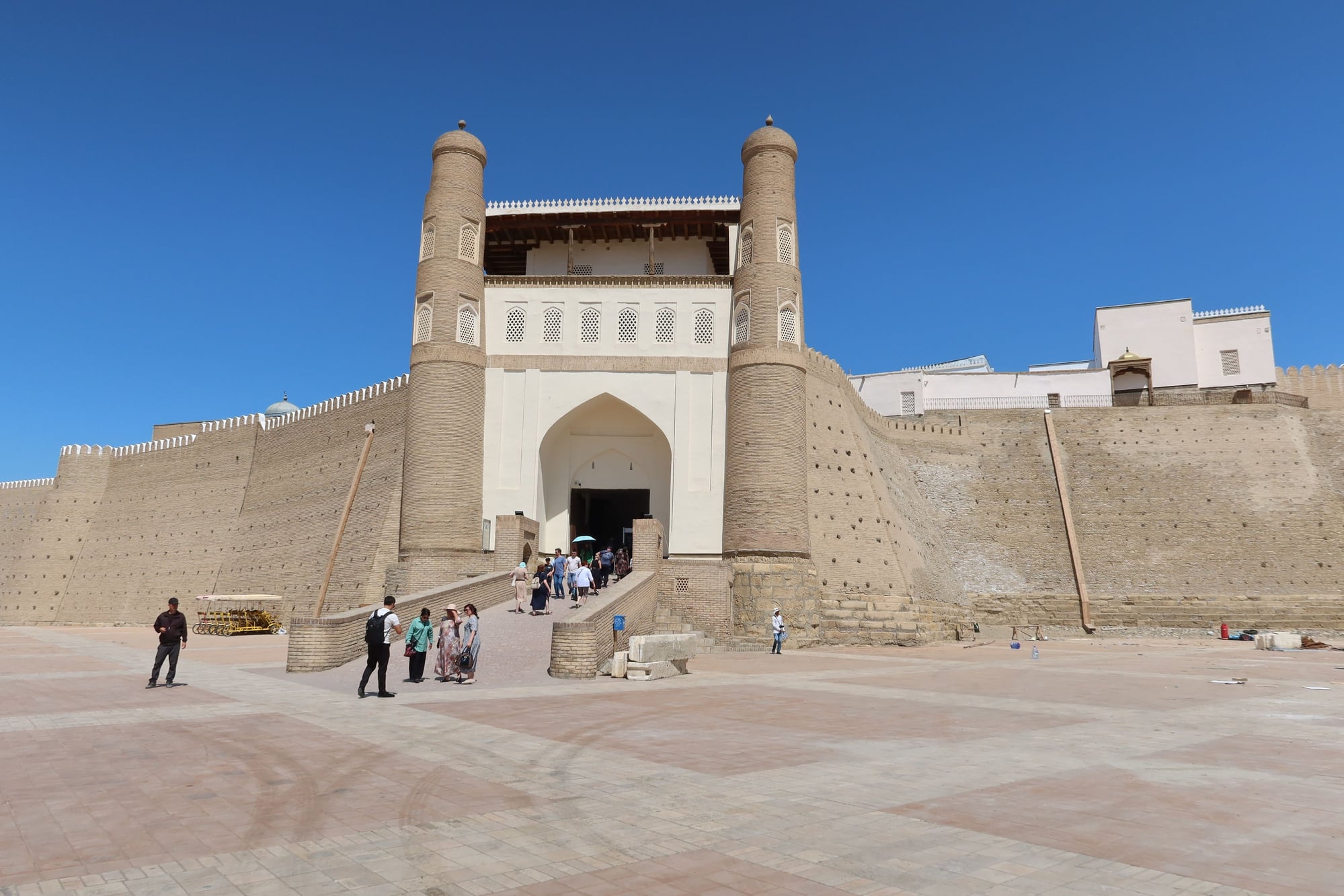
The Ark

Domes and Minarets Viewed from the Ark
Nelson, you're welcome. Now I may check out the book when I get back.
May 12: Bukhara
Happy Mother’s Day. We’re now in the fabled city of Bukhara. Bukhara sat at a nexus of sorts of the Silk Road, with China to the East, India to the South, Persia and the Arab World to the southwest, and Europe to the northwest. It was a place where goods as well as ideas exchanged hands. As such, the city was once a major center of learning, culture, arts and crafts, as well as commerce. Today we play the role of modern-day Silk Road travelers, especially as we wandered some of the lanes, thoroughfares, and markets all around the city.
We began the day with breakfast at our hotel, Alexia Suites, which is a beautifully-appointed and comfortable boutique hotel just a block away from Lab-i-Hauz. The courtyard style building with its decorative focal points would be right at home in Fez and Marrakesh, and really brought back wonderful memories of our trip there in 2021. The only downside, the hotel only accepted cash payment, and this was not made clear at the time of booking.
Our visit of the old city center started at Chor Minor, an unique mosque with four minaret build directly on the roof of the place of worship instead of next to or nearby it. Each of the four minarets sported different designs, including one featuring a nest with two storks. From here we headed back west to Lab-i-Hauz with its three buildings: Nadir Divan-Beghi Madrasa on the east side, Kukeldash Madrasa on the north, and Nadir Divan-Beghi Khankah on the west. The façade of Nadir Divan-Beghi Madrasa is spectacular with its Persian-style decorations featuring flowers, animals, geometric shapes, and calligraphy, all in different shades of blue and turquoise. The madrasa houses a small museum depicting how the space was once used as a school and residence while the rest of the many spaces have been taken over by souvenir shops hawking typical tourist ware. The same goes for Kukeidash Madrasa and the Kkankah, although both are clothed in much more subtle colors and ornamentation.
We continued west to the city’s numerous covered bazaars: the moneychangers’ bazaar, the capmakers’ bazaar, and the jewellers’ bazaar. Today, you guessed it: it’s been fully invaded and occupied by vendors selling tourist chum. Think T-shirts, key rings, decorative plates, ceramics, and the like. Despite the subject of today’s business, I enjoyed the atmosphere in this area. Wandering among the stalls and along the streets with its buildings from yesteryear, I cannot help but feel transported back in time several centuries. Near the bazaars are two very important and grandiose buildings: Ulugbek Madrasa and Abdul Aziz Khan Madrasa. Each house small museums but are mostly occupied by souvenir shops. Not too far from the madrasas and the bazaars is Kalyan Mosque, with its minaret. Another mosque that would feel right at home in Persia, Kalyan featured hundreds of columns connected by arches. We wandered and got “lost” among the rows and rows of columns.
Not far from here is the Ark, the former residence of the ruling emirs of Bukhara. The exhibits here are fine-ish, but the views over the city are awesome. We also visited nearby Bolo Khaouz Mosque, Chashma Ayub Mausoleum, and the Samanid Mausoleum. Sprinkled throughout the day were also shopping and visits to a couple of teahouses to sip our beverages of choice and soak in the ambiance of a different era.
While I’ve never have had the opportunity to visit Iran, I have developed a romanticized image of the cities of Shiraz and Isfahan. At different points throughout the day today, those images kept on popping up in my head over and over again. I kept on wondering to myself, “Is this what Isfahan feels like?” In any case, I find myself falling in love with the refined, genteel character of the city. It’s one I wouldn’t mind lingering in for a bit longer.

Chor Minor

Nadir Divan-Beghi Madrasa

Nadir Divan-Beghi Khankah

Old Caravanserai

Abdul Aziz Khan Madrasa

Kalyan Mosque and Minaret

Kalyan Mosque

The Ark

Domes and Minarets Viewed from the Ark
#18
Join Date: Mar 2014
Posts: 4,492
Likes: 0
Received 0 Likes
on
0 Posts
I am very surprised to read about the large tour buses and tour groups in Khiva. Never would have expected that. Especially since I've never heard of Khiva.
It's not clear to me - do you have a tour guide with you? You have drivers but are you sightseeing with tour guides? Or are you on your own?
I remember quite a few years ago reading thursdaysd's trip report for central Asia. It was fascinating. Yours is only the second one I have seen on this part of the world.

It's not clear to me - do you have a tour guide with you? You have drivers but are you sightseeing with tour guides? Or are you on your own?
I remember quite a few years ago reading thursdaysd's trip report for central Asia. It was fascinating. Yours is only the second one I have seen on this part of the world.
Last edited by KarenWoo; May 12th, 2024 at 12:33 PM.
#19
tripplanner, the Sven Hedin book I read was My Life as an Explorer. It was a summary of all his travels, his individual expeditions each have their own book, impressive and pricey volumes in their early editions.
He doesn't stand up well to the passage of time due to his colonial / imperialistic attitudes, and mingling with the wrong crowd during World War ||, among other reasons. As a teen I was unaware of this and his book was just a rip-roaring adventure that contributed to my wanderlust.
He was pretty good sketch artist and his books have full page glossy plates. Here is a rough sketch of a madrassa in Samarkand for example, which perhaps you will see.
https://commons.wikimedia.org/wiki/File ven_Hedin_Ulugh_Beg_Madrasa.jpg
ven_Hedin_Ulugh_Beg_Madrasa.jpg
Great report, thanks!
He doesn't stand up well to the passage of time due to his colonial / imperialistic attitudes, and mingling with the wrong crowd during World War ||, among other reasons. As a teen I was unaware of this and his book was just a rip-roaring adventure that contributed to my wanderlust.
He was pretty good sketch artist and his books have full page glossy plates. Here is a rough sketch of a madrassa in Samarkand for example, which perhaps you will see.
https://commons.wikimedia.org/wiki/File
 ven_Hedin_Ulugh_Beg_Madrasa.jpg
ven_Hedin_Ulugh_Beg_Madrasa.jpgGreat report, thanks!


